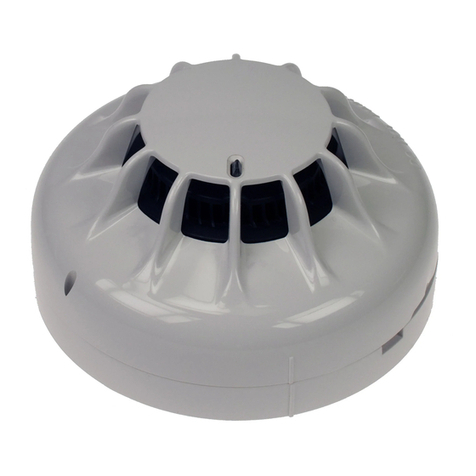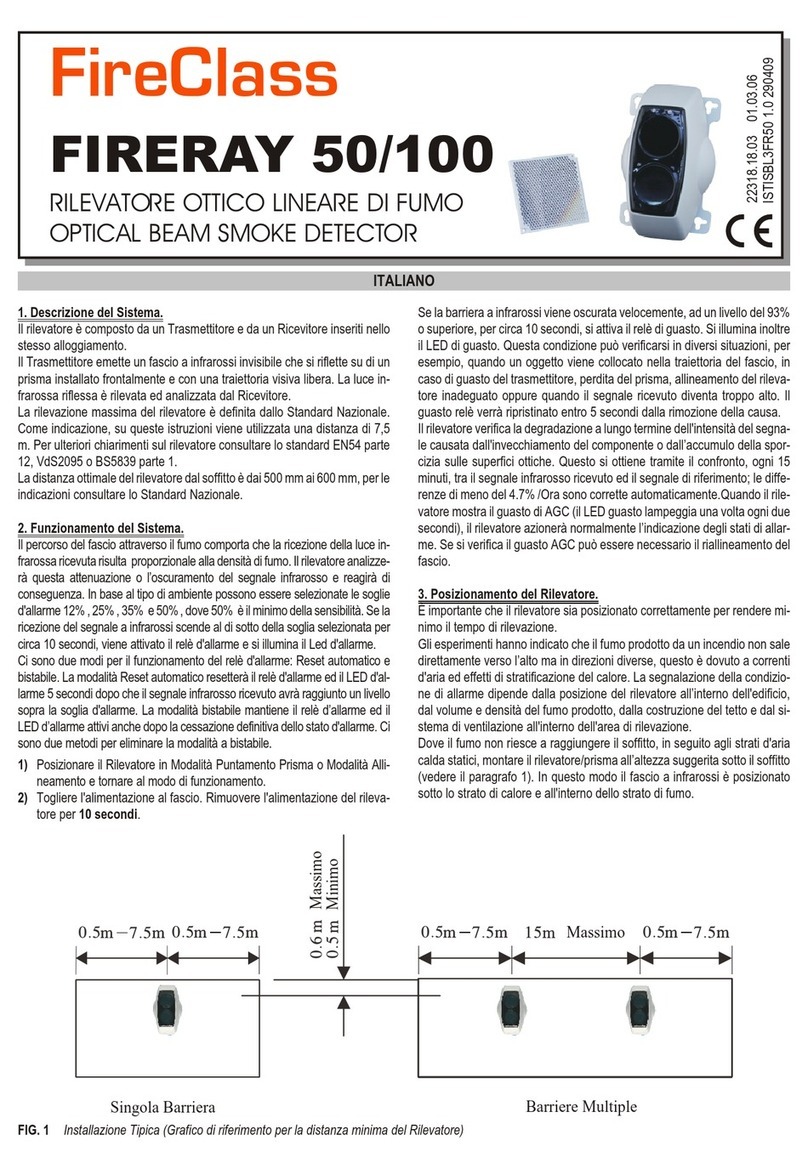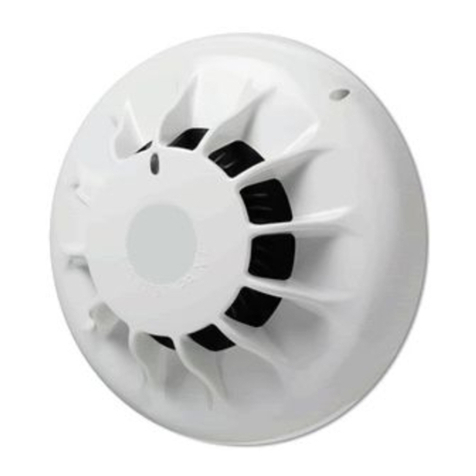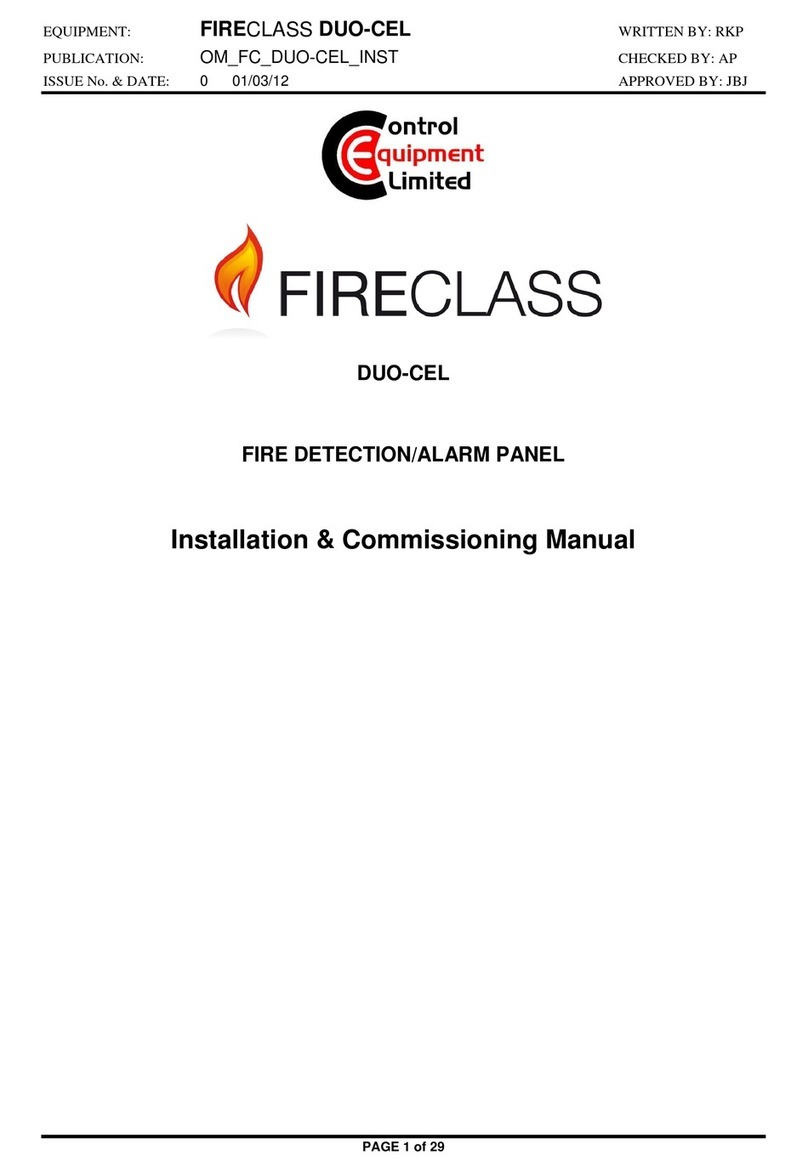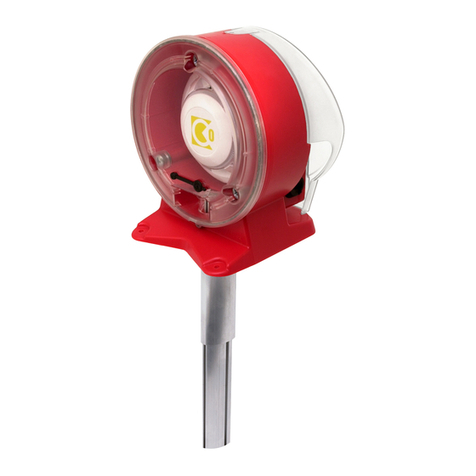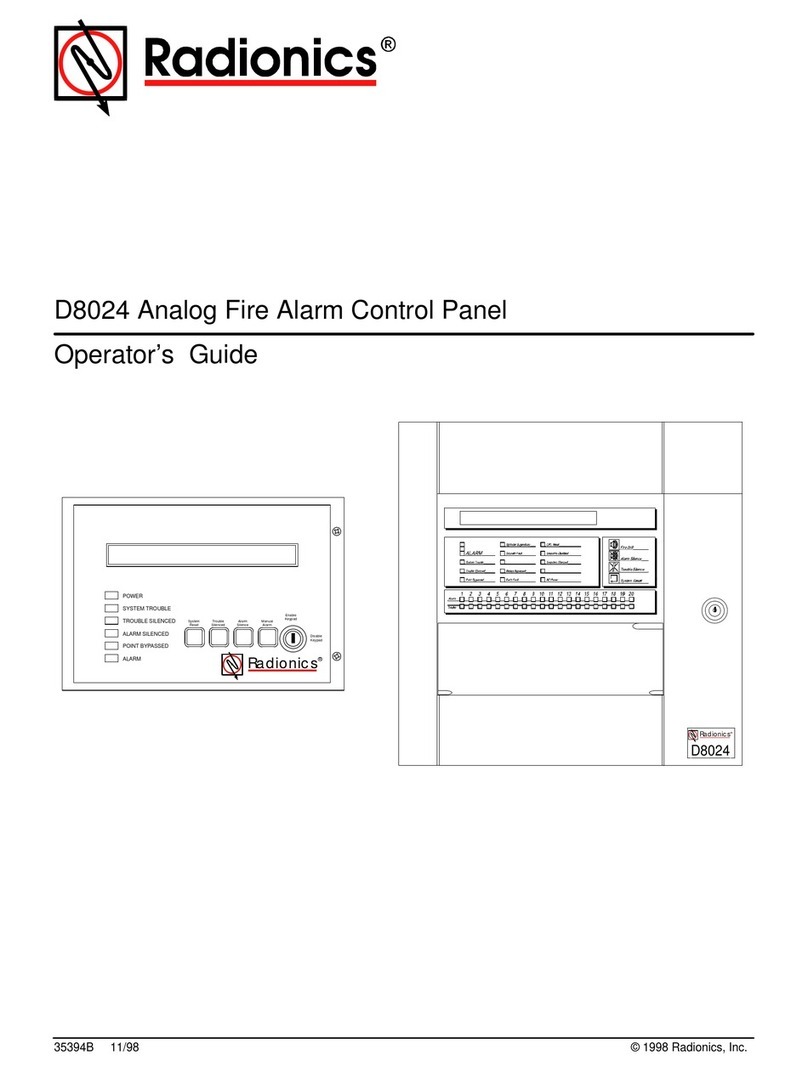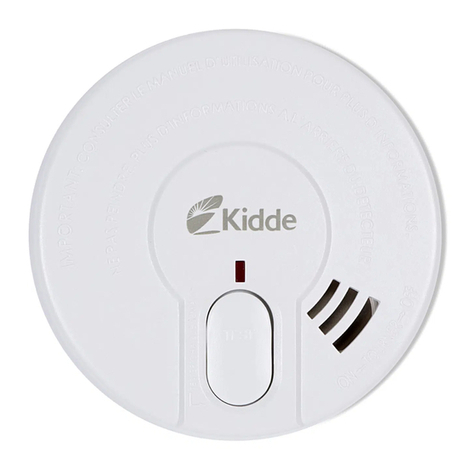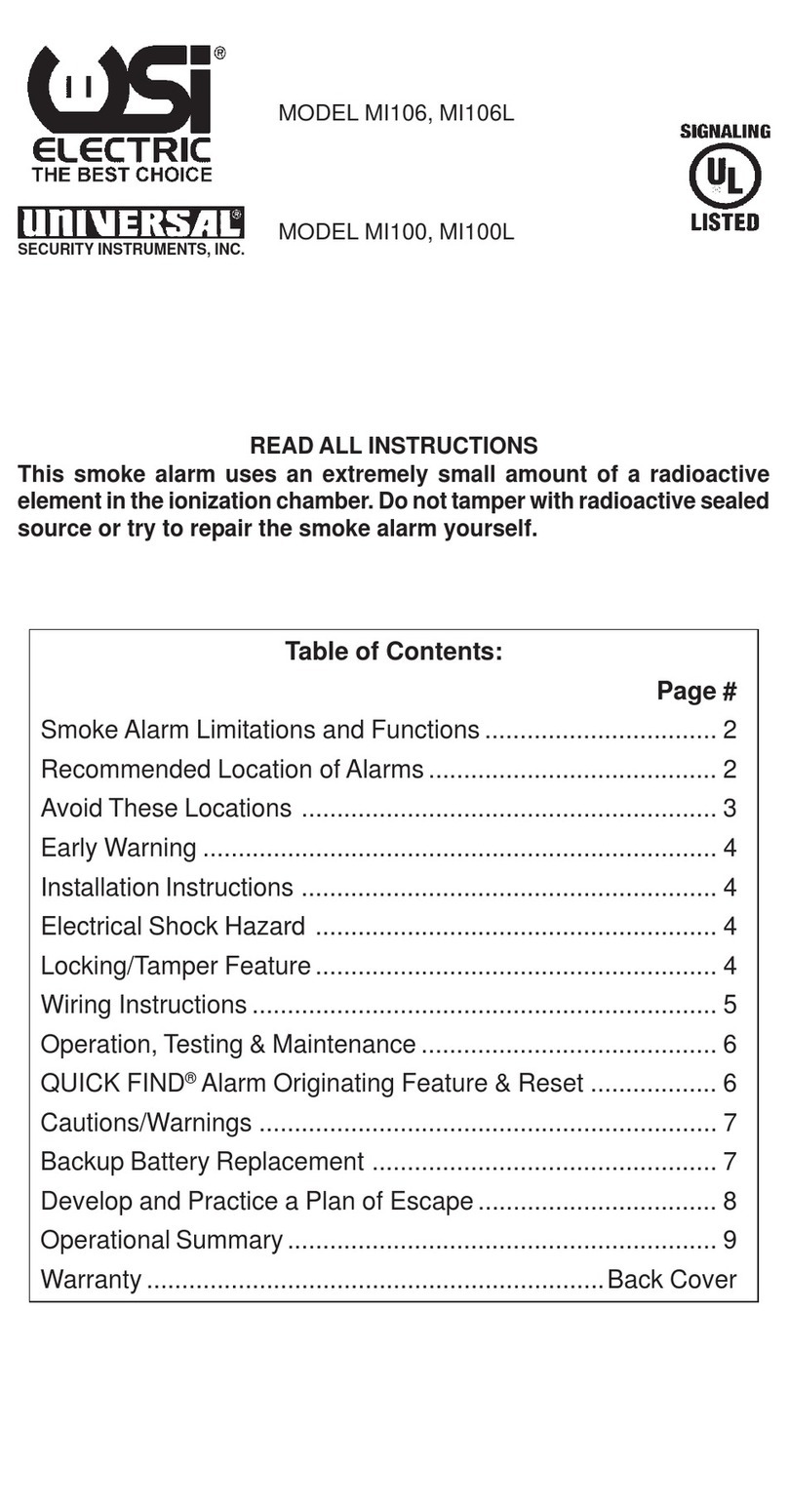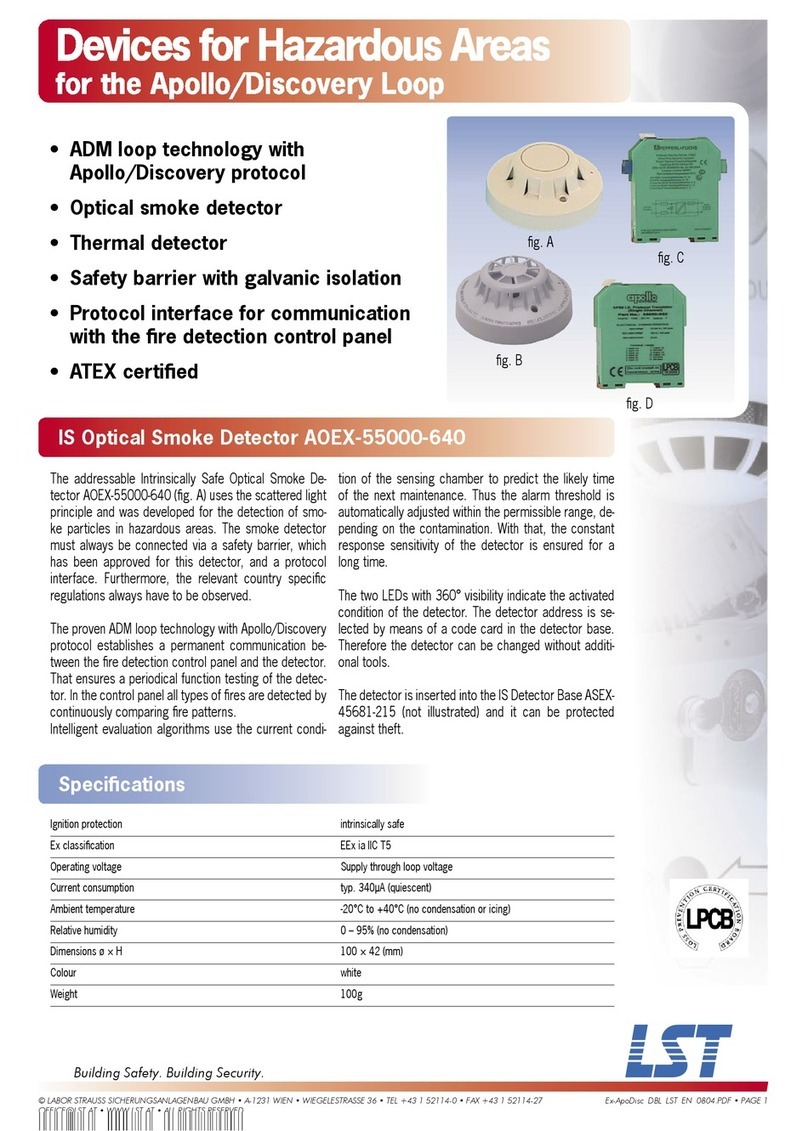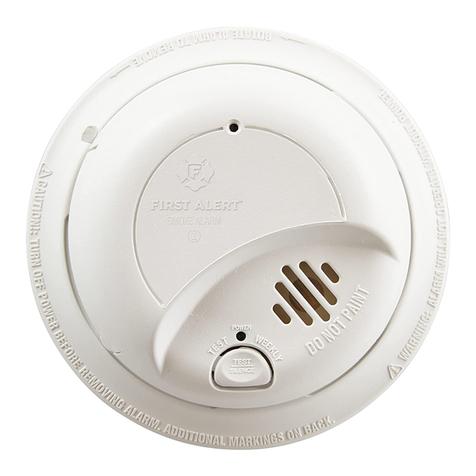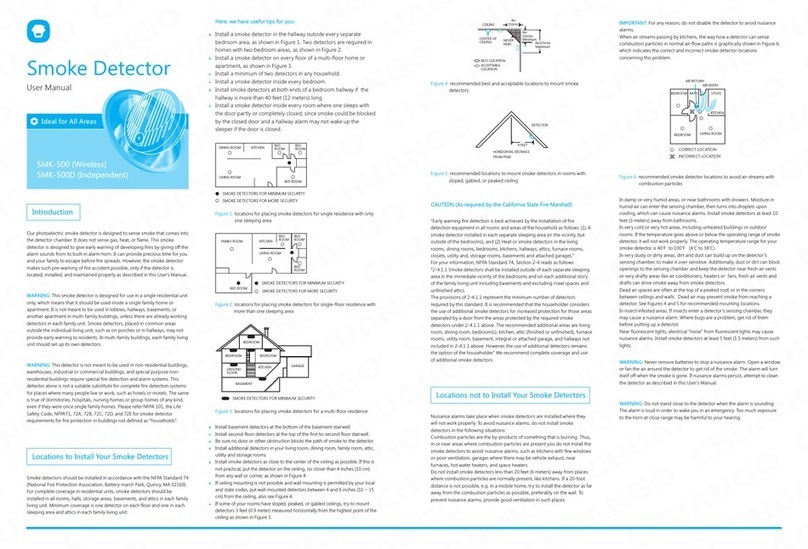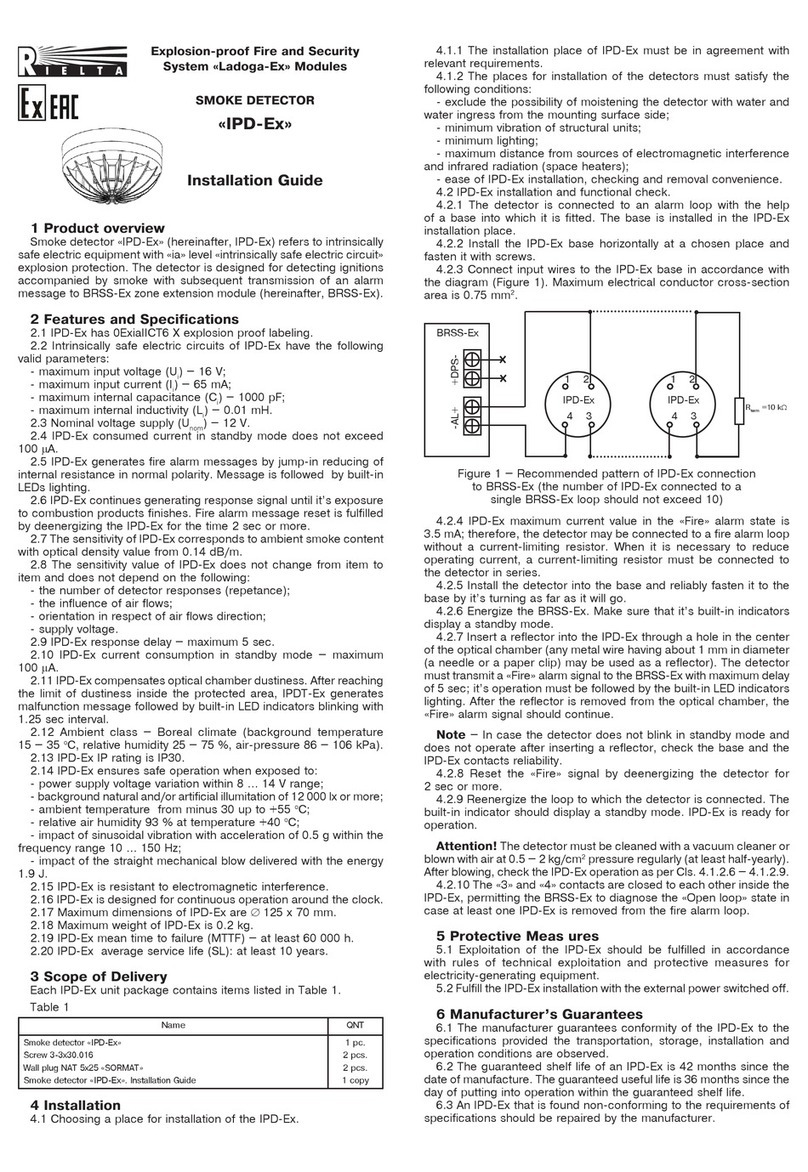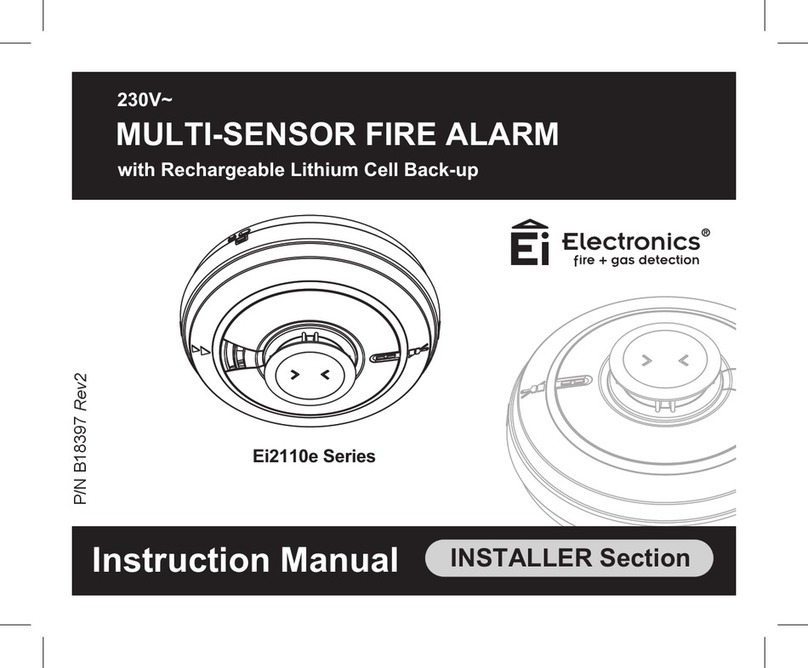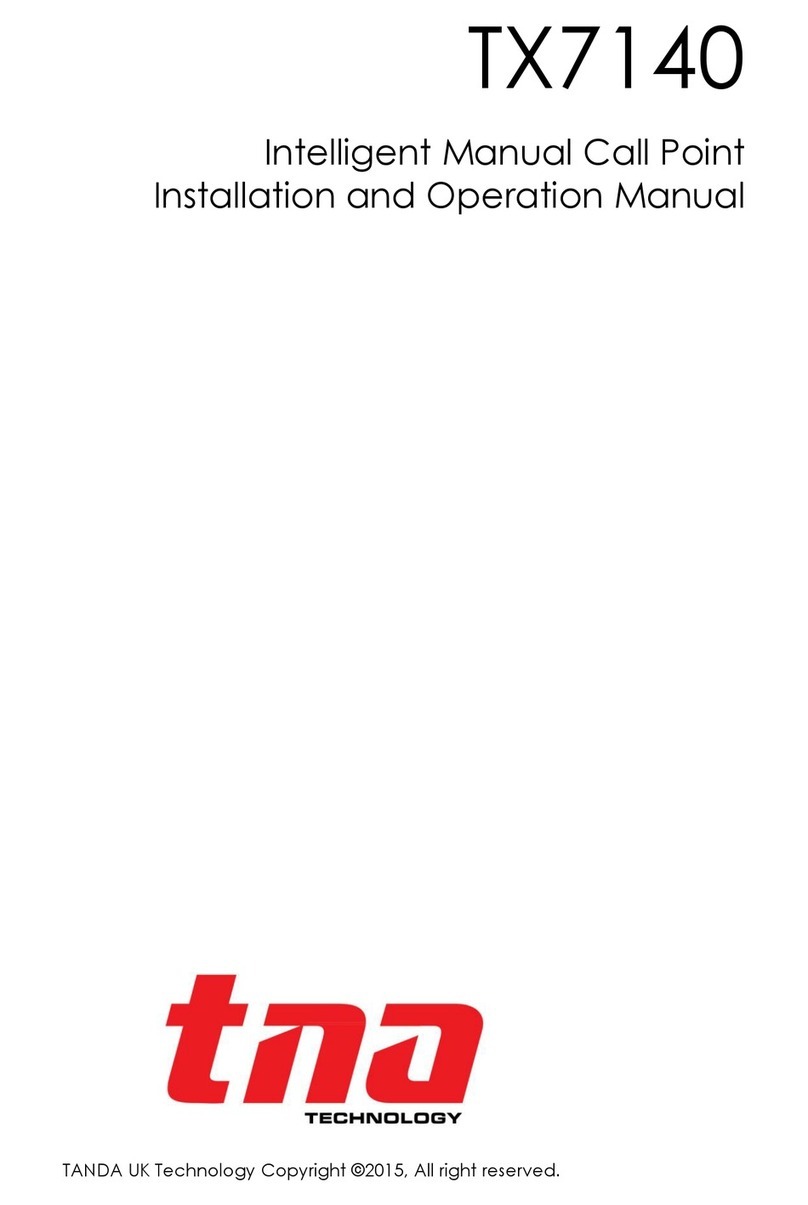FireClass Prescient III User manual

EQUIPMENT: FIRECLASS Prescient III WRITTEN BY: RKP
PUBLICATION: OMFCPRES3IN CHECKED BY: AP
ISSUE No. & DATE: 0 02/02/12 APPROVED BY:JBJ
PAGE 1 of 43
PRESCIENT III
FIRE ALARM & GAS EXTINGUISHING CONTROL PANEL
Application, Installation, Operation & Maintenance
Manual

EQUIPMENT: FIRECLASS Prescient III WRITTEN BY: RKP
PUBLICATION: OMFCPRES3IN CHECKED BY: AP
ISSUE No. & DATE: 0 02/02/12
PAGE 2 of 43
CONTENTS
1. INTRODUCTION ..................................................3
2. GENERAL DESCRIPTION.....................................3
3. FUNCTIONAL DESCRIPTION ................................8
3.9.1. REMOTE CONTROLS.....................................9
3.9.2. REMOTE SOUND ALARMS: ............................9
3.9.3. REMOTE SILENCE ALARMS:...........................9
3.9.4. REMOTE RESET:..........................................9
3.9.5. GAS TRAPPED.............................................9
3.9.6. AUTO/MANUAL LOCK-OFF SWITCH
(AUTO/MANUAL)......................................9
3.9.7. LOW PRESSURE FAULT (GAS LOW) ............9
3.9.8. EXTINGUISHING ISOLATION VALVE STATUS
(ISO. VALVE)..........................................10
3.9.9. GAS RELEASED PRESSURE SWITCH (GAS
REL.) ......................................................10
3.9.10. EMERGENCY HOLD (HOLD) .......................10
3.9.11. EMERGENCY ABORT INPUT (ABORT)..........10
3.10.1. FIRST STAGE SHUTDOWN (1STSTAGE)....11
3.10.2. SECOND STAGE SHUTDOWN (2ND STAGE)11
3.10.3. THIRD STAGE SHUTDOWN (3RD STAGE)...11
3.10.4. GAS DISCHARGED (GAS REL SIG)............11
3.10.5. FIRE SIGNAL (FIRESIG) ...........................11
3.10.6. FAULT SIGNAL (FAULT SIG)......................11
3.10.7. AUXILIARY RESET (RESET).......................11
3.12.1. FUNCTION SELECT SWITCH ........................12
3.12.2. LINK FOR EARTH FAULT MONITORING..........14
3.16.1. FIRE .......................................................15
3.16.2. FIRE SIGNAL..........................................15
3.16.3. ZONE 1...................................................15
3.16.4. ZONE 2...................................................15
3.16.5. AUX ZONE..............................................15
3.16.6. REMOTE SOUND ALARMS ...................16
3.16.7. FIRE SOUNDERFAULT/DISABLED......16
3.17.1. POWER SUPPLYON.............................16
3.17.2. GENERAL FAULT...................................16
3.17.3. POWER SUPPLYFAULT.......................16
3.17.4. SYSTEMFAULT.....................................16
3.17.5. EARTH FAULT........................................16
3.17.6. FUSE FAILED.........................................16
3.17.7. FAULT SIGNAL FAULT/DISABLED........16
3.17.8. SOUNDER TEST....................................16
3.18.1. AUTO&MANUAL...................................16
3.18.2. MANUAL ONLY ......................................16
3.18.3. MANUAL RELEASE ACTIVE..................16
3.18.4. SYSTEMACTIVATED ............................16
3.18.5. GAS RELEASED ....................................16
3.18.6. GAS RELEASED SIGNAL ACTIVE.........16
3.18.7. EMERGENCYABORT ACTIVE..............16
3.18.8. EMERGENCYHOLD ACTIVE ................17
3.18.9. CIRCUIT FAULT.....................................17
3.18.10. GAS LOW...............................................17
3.18.11. GAS TRAPPEDIN MANIFOLD...............17
3.18.12. ISOLATION VALVE ABNORMAL............17
3.18.13. ISOLATION VALVE CLOSED.................17
3.18.14. MANUAL RELEASE FAULT/DISABLED.17
3.18.15. EXTINGUISHINGDISABLED.................17
3.18.16. GAS RELEASED SIGNAL DISABLED....17
3.18.17. SHUTDOWN OUTPUTS DISABLED ......17
3.18.18. SECONDS TO DISCHARGE ..................17
3.19.1. SILENCE ALARMS.................................17
3.19.2. RESOUND ALARMS ..............................17
3.19.3. FIRE RESET...........................................17
3.19.4. EXTINGUISHINGRESET.......................17
3.19.5. SILENCE BUZZER .................................18
3.19.6. AUTO&MANUAL /MANUAL ONLY .......18
3.19.7. SELECT ON/OFF....................................18
3.19.8. ENABLE..................................................18
3.19.9. DISABLE.................................................18
3.19.10. TEST.......................................................18
3.19.11. SCROLL..................................................18
4. PANEL OPERATION ......................................... 18
4.2.1. DISABLE,RE-ENABLE,TEST ........................19
4.2.2. CONFIGURE I.S. ZONES..............................19
4.2.3. CONFIGURE SLU (STATUS LAMP UNITS)......19
4.5.1. MANUAL ONLYMODE ...........................20
4.5.2. AUTOMATIC &MANUAL MODE.............20
4.6.1. MANUAL ONLYMODE ...........................20
4.6.2. AUTOMATIC &MANUAL MODE.............20
4.8.1. EMERGENCY HOLD OPERATION ...................21
4.8.2. EMERGENCY ABORT OPERATION .................21
5. TECHNICAL SPECIFICATION ............................. 21
6. STANDBY BATTERY REQUIREMENTS ................ 22
7. DETECTOR COMPATIBILITY.............................. 24
8. PANEL INSTALLATION...................................... 28
9. SYSTEM MAINTENANCE................................... 34
10. PCB LAYOUT DIAGRAM .................................. 35
11. PANEL EXPLODED VIEW.................................. 36
12. CONNECTION DIAGRAMS ................................. 37
13. MECHANICAL,ELECTRICAL &ENVIRONMENTAL
SPECIFICATION ............................................... 42
14. CONSTRUCTION PRODUCTS DIRECTIVE............ 43
Figures
FIGURE 1–ENCLOSURE DIMENSIONS........................ 4
FIGURE 2–MOTHERBOARD TERMINAL IDENTIFICATION
PART 1................................................... 5
FIGURE 3–MOTHERBOARD TERMINAL IDENTIFICATION
PART 2................................................... 6
FIGURE 4–PRESCIENT III BLOCK SCHEMATIC DIAGRAM
.............................................................. 7
FIGURE 5–DISPLAY............................................... 15
FIGURE 6–POWER SUPPLY CONNECTION DETAILS . 23
Tables
TABLE 1–RESET INHIBIT SETTINGS........................ 13
TABLE 2–CIRCUIT MODES ..................................... 18
TABLE 3–FLOAT CHARGE VOLTAGES FOR
POWERSONIC VRLA BATTERIES............ 23

EQUIPMENT: FIRECLASS Prescient III WRITTEN BY: RKP
PUBLICATION: OMFCPRES3IN CHECKED BY: AP
ISSUE No. & DATE: 0 02/02/12
PAGE 3 of 43
1. Introduction
The FIRECLASS Prescient III Gas Extinguishing
Control Panel is a stand-alone panel intended for
use with gas extinguishing systems. It has been
designed and approved to the European Standard
EN 12094-1:2003, as well as the relevant parts of
EN54-2:1997 & EN54-4:1997. The Prescient III also
incorporates the relevant recommendations of the
British Code of Practice BS7273-1:2000.
The Prescient III is fully compliant with the
mandatory requirements of EN54 parts 2 and 4
along with the following options with requirements:
1. EN54-2:1997 Clause 7.8 Outputs to fire alarm
devices (sounders).
2. EN54-2:1997 Clause 7.9 Outputs to fire alarm
routing equipment.
3. EN54-2:1997 Clause 8.9 Output to fault
warning routing equipment.
4. EN54-2:1997 Clause 10 Test condition.
The Prescient III provides the following compulsory
functions of BSEN 12094-1:2003 as listed in clause
4.3.2:
1. a) Reception & processing of at least one input
triggering signal from an f.d.a.s. (Fire detection
Zones 1 & 2) and an input triggering signal
from manual triggering device(s) connected
directly to the e.c.d. (Manual Release input).
2. b) Transmission of the extinguishing signal
(Actuator circuits 1 & 2)
3. c) Activation of Alarm devices (Extinguishing
Sounder circuit)
4. d) Indication of each condition unambiguously
(LEDs & internal buzzer).
5. e) Transmission of the information of the
incorrect status of components and of the
information of the fault warning condition (Fault
Signal Output).
6. f) Transmission of the information of the
released condition (Gas Released Output)
The Prescient III provides the following optional
functions of BSEN 12094-1:2003 as listed in clause
4.3.2:
1. g) Extinguishing system delay.
2. h) Reception of a signal representing the flow
of extinguishing agent (Discharged).
3. i) Monitoring of status of components:
a. Low pressure/low weight
4. j) Reception of signal from an emergency hold
device.
5. k) Separate monitoring of the status of non-
electrical disable device(s) (Isolation valve).
6. n) Input from auto/manual selector switches.
7. o) Transmission of a triggering signal to
equipment within the fire extinguishing system:
b. Optical warning devices (Status
indicators).
8. q) Transmission of signals to equipment
outside the fire extinguishing system (Shut
downs).
9. r) Reception of signal from an emergency
abort device.
10.u) Activation of alarm devices with different
signals. (2-stage sounders).
The Environmental Class as defined by clause 4.2
is:
Class A: temperature range -5 to +40 Deg C.
The Prescient III is fully compliant with the relevant
recommendations of BS 7273-1:2000. The following
safety critical aspects have been addressed:
1. 6.1.2 Avoidance of accidental discharge.
2. 6.4.3 A single short circuit in connections shall
not cause an extinguishant release.
3. 6.4.4 Protection against over voltages which
could cause an extinguishant release.
The Prescient III integrates the functions of a fire
alarm system and a gas extinguishing system. The
Prescient III monitors one extinguishing area and
one non-extinguishing area for fire conditions and
gives an appropriate audible and visual indication.
Zones 1 & 2 are used for coincident detection in the
extinguishing area and can be used to automatically
release the extinguishing gas. The Auxiliary zone
only provides an alarm indication. The Prescient III
also provides a facility for initiating the release of
extinguishing gas manually.
The Prescient III incorporates a 5 Amp switch-mode
power supply with Power Factor correction.
2. General Description
The Prescient III is housed in a metal enclosure
with a Manual Release facility mounted on the door.
The following functions are available on the front of
the panel:
1) Visual Indication of panel status via LEDs:
2) Numerical Display for the Extinguishant
Release Timer.
3) Buttons for User Control.
4) Manually operated Extinguishant Release unit
The following functions are available inside the
panel:
1) Three fully monitored Detection circuits.
2) One fully monitored Manual Release circuit.
3) Two fully monitored General Sounder circuits.
4) One fully monitored Extinguishing Sounder
circuit.
5) Two fully monitored Actuator circuits.

EQUIPMENT: FIRECLASS Prescient III WRITTEN BY: RKP
PUBLICATION: OMFCPRES3IN CHECKED BY: AP
ISSUE No. & DATE: 0 02/02/12
PAGE 4 of 43
6) Repeater outputs for:
(i) Zone 1 Fire Detected
(ii) Zone 2 Fire Detected
(iii) Auxiliary Zone Fire Detected
(iv) Manual Release Activated
(v) Extinguishing System Disabled
(vi) Isolation Valve Closed
(vii) Isolation Valve Abnormal
(viii) Emergency Hold Activated (configurable for
auto & manual mode)
(ix) Emergency Abort Activated (configurable
for manual only mode)
7) Two Auxiliary 24VDC supply outputs.
8) RS485 communication link to drive external
Status Lamp Units.
9) Fully monitored inputs for:
(i) Gas Discharged Pressure Switch
(ii) Gas Low Pressure Switch
(iii) Gas Isolation Valve
(iv) Gas Trapped In Manifold
(v) Emergency Hold Switch
(vi) Emergency Abort Switch
(vii) Manual Only (Lock-Off) Switch
(viii) Remote Controls Switches (Sound alarms,
Silence Alarms, Reset)
10) Fully Monitored Outputs (Configurable for
Volt-Free operation) for:
(i) First Stage Shutdown
(ii) Second Stage Shutdown
(iii) Third Stage Shutdown
(iv) Auxiliary Fire Signal
(v) Auxiliary Fault Signal
(vi) Gas Released Signal
11) Volt-Free Relay Contacts for Auxiliary
Equipment Reset
12) Terminals for Internal Standby Batteries
13) Site Configuration DIL Switches
14) Fault indication LEDs
15) Internal Buzzer
Figure 1 –Enclosure Dimensions
370.00 mm
325.00 mm 126.00 mm
4.00 mm
FIRE STATUS
COMMON STATUS
USER CONTROLS EXTINGUISHING STATUS
FIRE
FIRE SIGNAL
ZONE 1
ZONE 2
AUX ZONE
REMOTE SOUND ALARMS
REMOTE CONTROLS FAULT
FIRE SOUNDER FAULT/DISABLED
POWER SUPPLY ON
GENERAL FAULT
POWER SUPPLY FAULT
SYSTEM FAULT
EARTH FAULT
FUSE FAILED
FAULTSIGNAL FAULT/DISABLED
SOUNDER TEST
AUTO & MANUAL
MANUAL ONLY
MANUAL RELEASE ACTIVE
SYSTEM ACTIVATED
GAS RELEASED
GAS RELEASED SIGNAL ACTIVE
EMERGENCY ABORT ACTIVE
EMERGENCY HOLD ACTIVE
CIRCUITFAULT
GAS LOW
GASTRAPPED IN MANIFOLD
ISOLATION VALVE ABNORMAL
ISOLATION VALVE CLOSED
MANUAL RELEASE FAULT/DISABLED
EXTINGUISHING DISABLED
GAS RELEASED SIGNAL DISABLED
SHUTDOWN OUTPUTS DISABLED
SECONDS
TO
DISCHARGE
SILENCE
ALARMS
FIRE
RESET
SILENCE
BUZZER
SELECT
ON/OFF
SCROLL
OFF
ACCESS
CONTROLS
ON
TEST
DISABLE
ENABLE
AUTO &MAN/
MANUAL ONLY
EXTINGUISHING
SYSTEM RESET
(INHIBITED)
RESOUND
ALARMS

EQUIPMENT: FIRECLASS Prescient III WRITTEN BY: RKP
PUBLICATION: OMFCPRES3IN CHECKED BY: AP
ISSUE No. & DATE: 0 02/02/12
PAGE 5 of 43
Figure 2 –Motherboard Terminal Identification Part 1
ZONE CIRCUITS
+-+-+-+-
1 2 AUX MR GAS
REL. GAS
LOW ISO.
VALVE GAS
TRAPPED Z1 Z2 AUX MR 1 2 3 4 5
OUTPUTS
HOLD ABORT REMOTE
CTRLS AUTO/
MANUAL
Repeat Output –Isolation Valve Abnormal
Repeat Output –Isolation Valve Closed
Repeat Output –Actuators Disabled
Repeat Output –Emergency Abort Activated
(Panel in Manual –DIL SW Selectable)
Repeat Output –Emergency Hold Activated
(Panel in Auto –DIL SW Selectable)
Repeat Output –Manual Release Activated
Repeat Output –Auxiliary Zone Fire
Repeat Output –Zone 2 Fire
Repeat Output –Zone 1 Fire
Status Input –Gas Trapped in Manifold
10K EOL, 680R Activation
Status Input –Isolation Valve Status
10K Abnormal, 2K2 = Open, 680R = Closed
Status Input –Gas Low
10K EOL, 680R = Gas Low
(DIL SW configurable for Normally closed
operation)
Status Input –Gas Released Pressure Switch
10K EOL, 680R = Activated
Manual Release Input
21VDC, 10K EOL, 680R = Activated
(DIL SW configurable for 3K9 EOL)
Auziliary Zone Input
21VDC, 22uF EOL, 680R = Activated
Detectors & Call-points allowed
(DIL SW configurable for 3K9 EOL)
Detector Zone 2 Input –Protected Area Zone
21VDC, 22uF EOL, 680R = Activated
Fire Detectors only
(DIL SW configurable for 3K9 EOL)
Detector Zone 1 Input –Protected Area Zone
21VDC, 22uF EOL, 680R = Activated
Fire Detectors only
(DIL SW configurable for 3K9 EOL)
Input –Emergency Hold Switch
10K EOL, 680R = Activated
Input –Emergency Hold Switch
10K EOL, 680R = Activated
Input
Auto/Manual Mode Select Switch
10K EOL, 4K7 = Manual Only Mode
Remote Control Input
10K EOL, 4K7 = Sound Alarms
1K8 = Silence Alarms
560R = Reset System

EQUIPMENT: FIRECLASS Prescient III WRITTEN BY: RKP
PUBLICATION: OMFCPRES3IN CHECKED BY: AP
ISSUE No. & DATE: 0 02/02/12
PAGE 6 of 43
Figure 3 –Motherboard Terminal Identification Part 2
24V 0V
AUX
250mA
A B
S.L.U.
+ - + - + - + - + -
SNDR1 SNDR2 EXT.
SNDR ACT1 ACT2 C/+ P O/-C/+ P O/-O/+ P C/-
C/+ P O/-C/+ P O/-C/+ P O/-
GAS REL SIG FIRE SIG FAULT SIG
C P O
RESET
3RD STAGE2ND STAGE1ST STAGE
Reset Relay - Volt-FreeTerminals:
C = Normally Closed
P = Pole
O = Normally Open
Fault Relay - Volt-Free or Powered
Terminals:
C/+ = Normally Closed or 24V out
P = Pole
O/- = Normally Open or 0V out
Fire Relay - Volt-Free or Powered
Terminals:
C/+ = Normally Closed or 24V out
P = Pole
O/- = Normally Open or 0V out
Gas Released Relay - Volt-Free or Powered
Terminals:
C/+ = Normally Closed or 24V out
P = Pole
O/- = Normally Open or 0V out
Actuator Circuit 2
+ = 1.2V in quiescent, 24V when activated
- = 3.8V in quiescent, 0V when activated
Actuator Circuit 1
+ = 1.2V in quiescent, 24V when activated
- = 3.8V in quiescent, 0V when activated
Extinguishing Sounder Circuit
+ = 1.2V in quiescent, 24V when activated
- = 3.8V in quiescent, 0V when activated
Fire Sounder Circuit 2
+ = 1.2V in quiescent, 24V when activated
- = 3.8V in quiescent, 0V when activated
Fire Sounder Circuit 1
+ = 1.2V in quiescent, 24V when activated
- = 3.8V in quiescent, 0V when activated
SLU 2-Wire RS485 Data Connection
Connect A at panel to A at SLU
Connect B at panel to B at SLU
1 Amp 24V DC Power Supply Output
Primarily for use with SLUs
250mA 24V DC Power Supply Output
Primarily for use with Repeat Outputs
Third Stage Relay
Volt-Free or Powered Terminals:
C/+ = Normally Closed or 24V out
P = Pole
O/- = Normally Open or 0V out
Second Stage Relay
Volt-Free or Powered Terminals:
C/+ = Normally Closed or 24V out
P = Pole
O/- = Normally Open or 0V out
First Stage Relay
Volt-Free or Powered Terminals:
C/+ = Normally Closed or 24V out
P = Pole
O/- = Normally Open or 0V out
24V 0V
AUX
1A

EQUIPMENT: FIRECLASS Prescient III WRITTEN BY: RKP
PUBLICATION: OMFCPRES3IN CHECKED BY: AP
ISSUE No. & DATE: 0 02/02/12
PAGE 7 of 43
Figure 4 –Prescient III Block Schematic Diagram
Zone 1
Zone 2
Aux Zone
Gas
Released
Gas
Low
Isol Valve
Abnormal
Isol Valve
Closed
Act 1**
Act 2**
Gen Sndr 1**
Gen Sndr 2**
Ext Sndr**
Gas Released
[Routing]**
Gas Released [SLU]
Gas Manual [SLU]
Gas Auto [SLU]
1st stage Plant
Shutdown **
Fire Sig
[Routing]**
Fault Sig
[Routing]**
Timer Hold [SLU]
Release Aborted [SLU]
+24V AUX 1A Output
2nd stage Plant
Shutdown **
Aux Reset
Coincidence
detection
zones
Auxiliary
detection zone
Panel
Manual
Release
Gas discharged
pressure switch.
Gas Low
[Low pressure
switch/low weight]
[Valve Closed]
[See valve
wiring diag]
Gas isolation
valve.
[Valve Stuck]
Fire
Z1
Fault/
Disabled
Z1
Fire
Z2
Fault/
Disabled
Z2
Fire
Aux
Fault/
Disabled
Aux
Gas
Released Fault
Gas Low
* = Open & short cct flt
monitored input*
*
*
Open & short cct flt monitored
I/P. 680 Ohm = Ext Low
Open & short cct flt
monitored I/P.
680Ohms = V/Closed
2K2 = V/Abnormal
General
Fire
Sounder
Test
General
Fire
Sounder
Fault/
Disabled
Sndr 1
flt Sndr 2
flt
Internal
Act 1 flt Act 2 flt
Internal Extinguishing
Disabled
Aux DC Supply Max O/P
1A Fused
Active on any fire Z1 or
Z2 in auto, Man Rel or
Gas Released P/S signal
Pulsed when Z1 & Z2 in alarm
in auto, or Man Release active.
Continuous on actuator
activation or discharge
Pressure SW I/P signal active
Max O/P: 0.5A
** = Open & short circuit
monitored output
Active on coincidence
fire on Z1 and Z2 in
auto, Man Rel or Gas
Released P/S signal
Fire Sig
[Routing]
Active Fault/
Disabled
Fault Sig
[Routing] Fault/
Disabled
S/D Outputs
Disabled
Gas Rel
Signal
[Routing]
Active Disabled
Operates on any fire
Z1,Z2,Aux Zone
Link configurable O/Ps:
Link ON:
Open/short cct fault
monitored, powered at
24 VDC when active.
Link OFF:
1 x Volt-Free Change-
over relay contact
[Rated 1 Amp @ 24VDC] Operates [de-energises]
on any fault including
Valve Abnormal but not
Valve Closed
Operates on Gas P/S
active I/P or Actuator
operated when in "No
Discharge P/S" mode
Open collector O/Ps
each rated 50 mA
1 x V/F C/O relay contact
[Rated 1 Amp @ 24VDC] Operating for 10
seconds after
operation of Fire
Reset switch
*
*
*
3rd stage Plant
Shutdown ** Active on Actuators
operated (if no
Discharged Pressure
Switch) or Gas
Released P/S signal
Each Plant Shutdown O/P has:
1 x OP, link configurable as fault
monitored/powered when active [as per fire
routing O/P] or 1 x V/F C/O relay contact
rated 1 Amp @ 24 VDC.
S/D
O/P
1 flt
Internal
S/D
O/P
2 flt
S/D
O/P
3 flt
Gas Trapped
Pressure
Switch
Gas Trapped
in Manifold
+24V AUX 250mA Output
Max O/P 0.25A [Fused]
Internal
Ext Sndr Fault
Release Disabled [SLU]
RP- E/Hold Active
orPanelinAuto
RP- E/AbortActive
orPanelinManual
RP - Isol Valve Closed
RP - Isol Valve Abnormal
RP –Actuators (Extinguishing)
Disabled
Internal
Fault
Internal
Auto
&
Manual Manual
Only Fault
Internal
E Abort
Active Fault
Internal
E Hold
Active Fault
Internal
Isolation
Valve
Abnormal
Isolation
Valve
Closed Fault
Internal
Gas
Trapped in
Manifold Fault
Internal
0V AUX 1A Output
Release Count Down[SLU]
RS485 serial
data [SLU]
To Status
Indicator/
Controller
SLU
Fault
Internal
Man
Rel
Active
Man
Rel
Fault/
Disabled
Internal
Gas Rel Sig
[Routing] Fault
Conventional
Manual Release
Zone
Manual
Release
Conventional
E Hold input Emergency
Hold
Conventional
Abort input
Emergency
Abort
*
*
*
*
Conventional
Auto/Manual
switch input
Auto/Manual
Lock Off *
RCI
Remote Controls Input:
4K7 = Sound Alarms
1K8 = Silence Alarms
560R = Reset Panel
Remote
Sound
Alarms
Active RCI
Fault
*
RP - Fire Z1
RP - Fire Z2
RP - Fire Aux Zone
RP –Manual Release Operated
DILSwitch
Selectable
Continuousforfireon
Z1,Z2,AuxZone.
AlsoforRemoteSoundAlarm
MaxO/P:0.5A
Operate on Pre-discharge
Timer Ended or Man Release
in Immediate mode
Max O/P:1 Amp
Internal
Fault
Panel
MR
Internal
Fault
External
MR
Extinguishing
Reset
Inhibit
ActiveIlluminates steady
while Extinguishing
Reset is Inhibited

EQUIPMENT: FIRECLASS Prescient III WRITTEN BY: RKP
PUBLICATION: OMFCPRES3IN CHECKED BY: AP
ISSUE No. & DATE: 0 02/02/12
PAGE 8 of 43
3. Functional Description
Note: Please refer to Section 10 for PCB Layout
Diagram and Section 12 for Connection
Diagrams.
3.1 Detection Zones (Zone 1, Zone 2 &
Aux Zone)
Three detection zone circuits are provided. They are
monitored for Open Circuit Fault, Short Circuit Fault
and Alarm (Fire). The End-Of-Line device is
normally a 22uF capacitor (or 10k resistor if set to
Intrinsically Safe mode) but can be configured for
3k9 resistor via a DIL switch on the motherboard.
A maximum of 32 devices may be connected on
each zone (the actual number is dependent on the
type of detector used, see section 7).
Manual Call Points may only be connected to the
aux. zone.
In Automatic mode, zones 1 and 2 are normally
used together to produce First Stage (pre-activated)
and Second Stage (activated) fire alarms, resulting
in automatic extinguishant discharge („Double
Knock‟ or „Coincidence‟ Zones).
The auxiliary detection zone only provides a general
fire indication.
Operation of Fire Reset causes the power supply to
all three zones to be disconnected for 4 seconds to
reset any activated detectors.
The Display Board has Fire and Fault LEDs for
each of the zones.
The Display Board also provides User Controls for
disabling the monitoring of individual zones.
3.2 Manual Release Facility (MR &
Panel Mounted Call Point)
Two circuits are provided for operating the Manual
Release facility.
1. The fourth detection zone is used as a Manual
Release zone. It is monitored for Open Circuit
Fault, Short Circuit Fault and Alarm. The End-
Of-Line device is usually a 10k resistor but can
be configured for 3k9 resistor via a DIL switch
on the motherboard.
It gives a Second Stage alarm in both
automatic and manual modes, and initiates the
Extinguishant release sequence when
activated.
This zone must only have manually operated
devices connected to it e.g. Manual Call Points.
The power supply to this zone is not switched
off during panel Reset.
2. A Manual Release Call Point is mounted on the
door of the panel and is monitored by a
separate circuit for open & short circuit faults.
The connection for the call point is on the rear
of the display board.
The Display Board has Activated and Fault LEDs for
the Manual Release facility, common to both
circuits. Individual fault LEDs are provided on the
motherboard inside the panel.
The Manual Release facility can be disabled,
resulting in both circuits being disabled.
3.3 General Alarm Circuits (SNDR1 &
SNDR2)
Two fully monitored general alarm circuits are
provided. They are monitored for Open Circuit and
Short Circuit faults. They are rated at 0.5A
(electronically fused), 28VDC each. The End-Of-
Line device is a 10k resistor (3k9 can also be used).
The Fire Sounder Fault/Disabled LED on the display
flashes for any fault conditions on the General
Alarm Circuits. Individual fault LEDs are provided on
the motherboard inside the panel. Both circuits can
be disabled as a group.
Note: The circuits are reverse-polarity monitored.
The PCB terminals are marked for the active
polarity. Ensure that all connected devices are
polarised.
3.4 Extinguishing Alarm Circuit (EXT
SNDR)
One fully monitored extinguishing alarm circuit is
provided, monitored for Open Circuit and Short
Circuit faults. It is rated at 0.5A (electronically
fused), 28VDC. The End-Of-Line device is a 10k
resistor (3k9 can also be used).
The Circuit Fault LED on the display flashes for any
fault condition on the Extinguishing Alarm Circuit,
with an individual fault LED on the motherboard
inside the panel. The circuit can be disabled by
disabling the extinguishing system (the Actuators
are also disabled at the same time).
Note: The circuit is reverse-polarity monitored. The
PCB terminals are marked for the active polarity.
Ensure that all connected devices are polarised.
3.5 Actuator Circuits (ACT1 & ACT2)
Two fully monitored actuator circuits are provided.
They are monitored for Open Circuit and Short
Circuit faults (short circuit fault indication can be
disabled). They are rated at 1A (fused), 28VDC
each. The End-Of-Line device is a 10k resistor (3k9
can also be used).
The Circuit Fault LED on the display flashes for any
fault condition on either Actuator Circuit, with
individual fault LEDs on the motherboard inside the
panel. Both circuits can be disabled by disabling the
extinguishing system (the Extinguishing Alarm
circuit is also disabled at the same time).
Note: The circuits are reverse-polarity monitored.
The PCB terminals are marked for the active
polarity. Ensure that all connected devices are
polarised.

EQUIPMENT: FIRECLASS Prescient III WRITTEN BY: RKP
PUBLICATION: OMFCPRES3IN CHECKED BY: AP
ISSUE No. & DATE: 0 02/02/12
PAGE 9 of 43
3.6 Repeater Outputs (Z1, Z2, AUX,
MR, OUTPUTS 1, 2, 3, 4, 5)
Each repeater output consists of an Open Collector
transistor driver capable of sinking up to 50mA. The
following outputs are provided:
Z1 –Zone 1 Fire
Z2 –Zone 2 Fire
AUX –Auxiliary Zone Fire
MR –Manual Release Activated
OUTPUT 1–Emergency Hold Activated
(configurable for auto & manual mode)
OUTPUT 2–Emergency Abort Activated
(configurable for manual only mode)
OUTPUT 3–Actuators (Extinguishing) Disabled
OUTPUT 4–Isolation Valve Closed
OUTPUT 5–Isolation Valve Abnormal
3.7 Auxiliary 24VDC Supply
The panel provides two auxiliary 24Vdc power
supply outputs for connection to ancillary
equipment:
1. (AUX 250mA: 24V, 0V) –This output is rated
at 250mA (electronically fused), 24 Volts D.C.
2. (AUX 1A: 24V, 0V) –This output is rated at 1A
(electronically fused), 24 Volts D.C.
3.8 Status Lamp Unit
The panel communicates with the Status Lamp
Units (SLU) via two-wire RS485 serial data. The
following indications can be provided, dependent on
SLU type:
1. Emergency Abort Activated
2. Emergency Hold Activated
3. Gas Released
4. Auto & Manual
5. Manual Only
6. Extinguishing Disabled
7. Local Fault
8. Seconds Remaining to Discharge (fully
functional SLU only)
The SLU can provide the following controls,
dependent on SLU type:
1. Manual Release
2. Emergency Abort
3. Emergency Hold
4. Auto & Manual / Manual Only
The controls on the SLU can be transmitted via the
serial data link or hard-wired via conventional
circuits on the panel (see 3.9 below).
3.9 Remote Inputs
3.9.1. Remote Controls
This is a fully monitored input, providing: open &
short circuit fault monitoring, Silence Alarms, Re-
sound Alarms and Panel Reset. The EOL device
is a 10k resistor.
3.9.2. Remote Sound Alarms:
Non-latching.
4k7 = activate general sounders.
When activated –steady „Remote Sound
Alarms‟indication and continuous operation of
general sounders.
When deactivated –„Remote Sound Alarms‟
indication clears and general sounders stop.
3.9.3. Remote Silence Alarms:
Single Operation.
1k8 = silence active sounders (silencing of
extinguishing sounders is inhibited until the
Discharged condition is active)
When activated –same operation as pressing
the Silence Alarms button.
When deactivated –no action
3.9.4. Remote Reset:
Single Operation.
560R = Reset Fire System & Extinguishing
System (reset of the extinguishing system can
be inhibited until the inhibit timer ends or Abort
is operated)
When activated –Resets all indications on the
Fire Alarm section of the panel. Only resets the
indications on the Extinguishing section of the
panel if the Reset Inhibit is inactive.
When deactivated –no action
3.9.5. Gas Trapped
This is a fully monitored input, providing open &
short circuit fault monitoring. The EOL device is a
10k resistor, activated by a 680R resistor.
Activation illuminates the GAS TRAPPED IN
MANIFOLD LED and raises the general fault
condition.
3.9.6. Auto/Manual Lock-Off Switch
(AUTO/MANUAL)
The Auto/Manual input is fully monitored for open
& short circuit faults. The End-Of-Line device is a
10k resistor, activated by a 4k7 resistor. In the
active state the panel is placed in Manual Only
mode and the yellow Manual Only LED on the
display board pulses. Operation of the
Auto/Manual button on the display board has no
effect while the input is active. The input allows for
the connection of Auto/Manual Lock-Off switches
on SLUs. Door Lock switches may also be
connected via terminals on the SLUs. The total
number of Auto/Manual switches & Door Lock
switches that can be connected is 14. This allows
for 7 SLUs, each with an auto/manual Keyswitch
and a door lock switch fitted. See the SLU
installation manual for more details.
3.9.7. Low Pressure Fault (GAS LOW)
This is a fully monitored input, providing open &
short circuit fault monitoring. The EOL device is a
10k resistor, activated by a 680R resistor.
Activation illuminates the GAS LOW LED and

EQUIPMENT: FIRECLASS Prescient III WRITTEN BY: RKP
PUBLICATION: OMFCPRES3IN CHECKED BY: AP
ISSUE No. & DATE: 0 02/02/12
PAGE 10 of 43
raises the general fault condition. An open or short
circuit fault is indicated by the Circuit Fault LED on
the display and a Gas Low Fault LED on the
motherboard. The input is configurable for
normally open or normally closed operation via a
DIL switch on the motherboard.
3.9.8. Extinguishing Isolation Valve Status
(ISO. VALVE)
This is a fully monitored input, providing open &
short circuit fault monitoring. The EOL device is a
10k resistor, giving an „ISOLATION VALVE
ABNORMAL‟ indication. An open or short circuit
fault is indicated by the Circuit Fault LED on the
display and a Isolation Valve Fault LED on the
motherboard. Three states are possible on the
input:
1. Valve Closed:
Activated by a 680R resistor; flashing the
Valve Closed LED on the display board &
pulsing the internal buzzer.
2. Valve Open:
Activated by a 2k2 resistor; no indication is
given on the panel as this is the healthy state
for the input.
3. Valve Abnormal:
Activated by the 10k EOL resistor; flashing
the Valve Abnormal LED on the display board
& raising a general fault indication. A 2-
second delay is applied to the abnormal
condition to avoid momentary activation
during normal movement of the valve
between open and closed positions.
See Connection Diagram in section 12.3 for
details.
NOTE: The healthy state for the input is
VALVE OPEN and therefore, if the input is not
used, the input should have a 2k2 resistor
fitted.
3.9.9. Gas Released Pressure Switch (GAS
REL.)
This is a fully monitored input, providing open &
short circuit fault monitoring. The EOL device is a
10k resistor. An open or short circuit fault is
indicated by the Circuit Fault LED on the display
and a Gas Released Fault LED on the
motherboard. The input is activated by a 680R
resistor, illuminating the Gas Released LED on the
display, the Extinguishing sounder circuit, the Gas
Released Signal & all three shutdown outputs.
3.9.10. Emergency Hold (HOLD)
This is a fully monitored input, providing open &
short circuit fault monitoring. The EOL device is a
10k resistor. An open or short circuit fault is
indicated by the Circuit Fault LED on the display
and a Hold Fault LED on the motherboard. If a
fault occurs on the input during the Activated or
Discharged condition then the fault indication is
still given but the Hold Active LED is illuminated
steady and the Hold condition is established until
the fault is removed. This fault condition
prevents the Extinguishant release.
The input is activated by a 680R resistor,
illuminating the Emergency Hold Active LED on
the display and resetting & holding the pre-
discharge delay timer.
NOTE: If more than three Emergency Hold
switches connected to the Hold input are
operated simultaneously then a short circuit
fault will be detected. If this occurs while the
Pre-discharge timer is running, then the Timer
will still be reset and held until all switches are
released. Use only non-latching switches
which return to open contacts when the switch
is released.
NOTE: If a SLU with a Hold switch is
configured to transmit the Hold signal via the
serial communications path, a communication
fault on this path will initiate the Hold
condition, as described above, and the release
of extinguishant will be inhibited.
3.9.11. Emergency Abort Input (ABORT)
This is a fully monitored input, providing open &
short circuit fault monitoring. The EOL device is a
10k resistor. An open or short circuit fault is
indicated by the Circuit Fault LED on the display
and an Abort Fault LED on the motherboard. In
addition, the Abort Active LED will pulse if the
system is not in the Activated or Discharged
condition, clearing when the fault is cleared. If a
fault occurs on the input during the Activated or
Discharged condition then the fault indication is
still given but the Abort Active LED is illuminated
steady and the Abort condition is latched until
reset. This fault condition prevents the
Extinguishant release.
The input is activated by a 680R resistor,
illuminating the Emergency Abort Active LED on
the display and stopping the Extinguishant
release. The active abort condition is latched until
the input is cleared and the Extinguishing Reset
button is pressed.
NOTE: Use only LATCHING switches which
need to be manually returned to the OFF
position (this is a requirement of EN 12094-
1:2003 clause 4.27.2)
NOTE: If a SLU with an Abort switch is
configured to transmit the Abort signal via the
serial communications path, a communication
fault on this path will initiate the Abort
condition, as described above, and the release
of extinguishant will be aborted.

EQUIPMENT: FIRECLASS Prescient III WRITTEN BY: RKP
PUBLICATION: OMFCPRES3IN CHECKED BY: AP
ISSUE No. & DATE: 0 02/02/12
PAGE 11 of 43
3.10 Relay Contacts
Other than the Auxiliary Reset Relay, all Relay
outputs can be configured as either powered and
monitored outputs or Volt-free relay contacts. The
factory default is powered and monitored outputs as
required by EN54-2:1997 & EN12094-1:2003.
3.10.1. First Stage Shutdown (1ST STAGE)
The First Stage Shutdown Relay is energised
when the panel enters the pre-activated condition.
This occurs when the panel is in the AUTOMATIC
& MANUAL mode and a fire occurs on zone 1 or
zone 2. The relay is also energised if the panel
enters the 2nd Stage or 3rd Stage condition (see
3.10.2 and 3.10.3).
A triple jumper link allows the output to be
powered and monitored (Link ON) or Volt-Free
(Link OFF).
In the Monitored mode, an open or short circuit
fault on the field wiring illuminates the Circuit Fault
LED on the display and the 1st Stage Shutdown
Fault LED on the motherboard.
In the Volt-free mode, clean contacts for Pole,
Normally Open & Normally Closed are available,
rated at 1A, 30VDC.
3.10.2. Second Stage Shutdown (2ND
STAGE)
The Second Stage Shutdown Relay is energised
when the panel enters the activated condition.
This occurs when the panel is in the AUTOMATIC
& MANUAL mode and a fire occurs on zone 1 and
zone 2, or the Manual Release is operated (in
Auto or Manual mode). The relay is also energised
if the panel enters the 3rd Stage condition (see
3.10.3).
A triple jumper link allows the output to be
powered and monitored (Link ON) or Volt-Free
(Link OFF).
In the Monitored mode, an open or short circuit
fault on the field wiring illuminates the Circuit Fault
LED on the display and the 2nd Stage Shutdown
Fault LED on the motherboard.
In the Volt-free mode, clean contacts for Pole,
Normally Open & Normally Closed are available,
rated at 1A, 30VDC.
3.10.3. Third Stage Shutdown (3RD STAGE)
The Third Stage Shutdown Relay is energised
when the pre-discharge delay timer ends & the
actuator circuits are operated. The relay is also
energised if the panel enters the discharged
condition due to operation of the Gas Released
Pressure Switch input (see 3.10.4).
A triple jumper link allows the output to be
powered and monitored (Link ON) or Volt-Free
(Link OFF).
In the Monitored mode, an open or short circuit
fault on the field wiring illuminates the Circuit Fault
LED on the display and the 3rd Stage Shutdown
Fault LED on the motherboard.
In the Volt-free mode, clean contacts for Pole,
Normally Open & Normally Closed are available,
rated at 1A, 30VDC.
3.10.4. Gas Discharged (GAS REL SIG)
The Gas Discharged Relay is energised when the
Gas Released Pressure Switch input is activated,
or when the actuator circuits are operated if the
panel is configured for NO PRESSURE SWITCH.
A triple jumper link allows the output to be
powered and monitored (Link ON) or Volt-Free
(Link OFF).
In the Monitored mode, an open or short circuit
fault on the field wiring illuminates the Circuit Fault
LED on the display and the Gas Released signal
Fault LED on the motherboard.
In the Volt-free mode, clean contacts for Pole,
Normally Open & Normally Closed are available,
rated at 1A, 30VDC.
3.10.5. Fire Signal (FIRE SIG)
The Fire Signal Relay is energised when zones 1,
2 or Aux zone detect a fire condition.
A triple jumper link allows the output to be
powered and monitored (Link ON) or Volt-Free
(Link OFF).
In the Monitored mode, an open or short circuit
fault on the field wiring illuminates the Fire Signal
Fault LED on the display.
In the Volt-free mode, clean contacts for Pole,
Normally Open & Normally Closed are available,
rated at 1A, 30VDC.
3.10.6. Fault Signal (FAULT SIG)
The Fault Signal Relay is a fail-safe relay and is
normally energised. It is de-energised for any fault
condition on the panel.
A triple jumper link allows the output to be
powered and monitored (Link ON) or Volt-Free
(Link OFF).
In the Monitored mode, an open or short circuit
fault on the field wiring illuminates the Fault Signal
Fault LED on the display.
In the Volt-free mode, clean contacts for Pole,
Normally Open & Normally Closed are available,
rated at 1A, 30VDC.
3.10.7. Auxiliary Reset (RESET)
The Auxiliary Reset Relay is a single pole change-
over relay and is energised briefly when the panel
is in Fire Reset mode. The relay is energised for
10 seconds. This is to allow ancillary equipment
such as Beam Detectors to be reset. The relay
has no powered and monitored mode and only
volt-free contacts for Pole, Normally Open &
Normally Closed are available, rated at 1A,
30VDC.

EQUIPMENT: FIRECLASS Prescient III WRITTEN BY: RKP
PUBLICATION: OMFCPRES3IN CHECKED BY: AP
ISSUE No. & DATE: 0 02/02/12
PAGE 12 of 43
3.11 Internal Standby Batteries
Terminals are provided to allow connection of one
set of internal standby batteries. The Charger
Circuit is monitored for the following:
Battery or associated wiring disconnected.
Battery fuse blown
Low battery voltage (<15.7V ±0.4V)
Battery and interconnection resistance is 0.35Ω
or higher.
3.12 Function Enable/Disable
Switches
Two sets of DIL switches and one jumper link are
available on the motherboard to allow the panel to
be configured for additional site-specific functions:
3.12.1. Function Select Switch
12 3 4 5
ON
CONFIG I/S INPUTS
PRE-DISCHARGE DELAY 5S
PRE-DISCHARGE DELAY 10S
SW1
7 8 9 10 11 126
PRE-DISCHARGE DELAY 20S
PRE-DISCHARGE DELAY 40S
SILENT ZONE TEST
BUZZER DISABLE
LATCHED FAULTS
INSTANT MANUAL RELEASE
BUZZER PULSES AT END OF DELAY
ZONES 1 & 2 SINGLE KNOCK
NO DISCHARGE PRESSURE SWITCH
SW2
12 3 4 5
ON
ACTUATOR S/C DISABLE
1 MIN
2 MIN
7 8 9 10 11 126
4 MIN
8 MIN
16 MIN
CLEAR ACTUATORS AFTER 1 MIN
SILENCE ALARMS BEFORE RESET
OUTPUT 1-AUTO, 2-MANUAL
CONFIG SLU
3K9 EOL
N/C GAS LOW I/P
RESET
INHIBIT
PERIOD
This consists of two sets of 12-way DIL switches,
providing the following options:
3.12.1.1. CONFIG I/S INPUTS
When in the ON position, enables zones 1, 2,
Aux zone and Manual Release input to be
individually configured for standard or
intrinsically safe monitoring. The circuits need to
be configured for I/S monitoring if Galvanic
Isolators or Zener Barriers are connected. I/S
zones will then be monitored for a 10k EOL
resistor and different monitoring limits due to the
I/S barrier/isolator series load. See section 4.2.2
for configuration details.
3.12.1.2. PRE-DISCHARGE DELAY (5S, 10S,
20S, 40S)
These four switches allow the Pre-discharge
delay timer to be configured from 0 to 60
seconds in 5-second increments. Any of the four
switches in the ON position adds to the delay
value, up to a maximum of 60 seconds.
Delay
Length
(Seconds)
SW1-2
(5S)
SW1-3
(10S)
SW1-4
(20S)
SW1-5
(40S)
0
OFF
OFF
OFF
OFF
5
ON
OFF
OFF
OFF
10
OFF
ON
OFF
OFF
15
ON
ON
OFF
OFF
20
OFF
OFF
ON
OFF
25
ON
OFF
ON
OFF
30
OFF
ON
ON
OFF
35
ON
ON
ON
OFF
40
OFF
OFF
OFF
ON
45
ON
OFF
OFF
ON
50
OFF
ON
OFF
ON
55
ON
ON
OFF
ON
60
N/A
N/A
ON
ON
3.12.1.3. SILENT ZONE TEST
Switch OFF:- A fire alarm on any zone in Test
Mode will operate the appropriate zonal fire
indicator and the general sounder circuits for
four seconds.
Switch ON:- A fire alarm on any zone in Test
Mode will operate the appropriate zonal fire
indicator but will NOT operate the general
sounder circuits.
3.12.1.4. BUZZER DISABLE
Switch OFF:- The internal buzzer operates for
any fire, fault or display button operation.
Switch ON:- The internal buzzer only operates
on operation of any display button.
Note: This is not compliant with EN54-2 or
EN12094-1. Provided for commissioning
purposes only.
3.12.1.5. LATCHED FAULTS
Switch OFF:- All fault indications are non-
latching and clear once the fault clears.
Switch ON:- All fault indications are latching and
require a manual reset via the FIRE RESET
and/or EXTINGUISHING SYSTYEM RESET
buttons.
3.12.1.6. INSTANT MANUAL RELEASE
Switch OFF:- Operation of Manual Release
starts the Pre-discharge delay timer.
Switch ON:- Operation of Manual Release
bypasses the Pre-discharge delay timer &
operates the actuator circuits immediately.

EQUIPMENT: FIRECLASS Prescient III WRITTEN BY: RKP
PUBLICATION: OMFCPRES3IN CHECKED BY: AP
ISSUE No. & DATE: 0 02/02/12
PAGE 13 of 43
3.12.1.7. BUZZER PULSES AT END OF
DELAY
Switch OFF:- No change in the state of the
internal buzzer during the last five seconds of
the Pre-discharge delay timer.
Switch ON:- The internal buzzer pulses during
the last five seconds of the Pre-discharge
delay timer.
3.12.1.8. ZONES 1 & 2 SINGLE KNOCK
Switch OFF:- If the system is set to Auto &
Manual mode, a fire condition on both zones
1 & 2 is required to start the pre-discharge
delay timer.
Switch ON:- If the system is set to Auto &
Manual mode, a fire condition on either zone
1 or zone 2 will start the pre-discharge delay
timer.
3.12.1.9. NO DISCHARGE PRESSURE
SWITCH
Switch OFF:- The Panel only indicates SYSTEM
DISCHARGED when the GAS REL. input is
activated (via a Discharge Pressure switch).
Switch ON:- The panel indicates SYSTEM
DISCHARGED as soon as the actuator
circuits are activated.
3.12.1.10. ACTUATOR S/C DISABLE
Switch OFF:- The actuator circuits are monitored
for open & short circuit faults.
Switch ON:- The actuator circuits are only
monitored for open circuit faults. Used for
open-circuit fault monitoring of the solenoid
coil without a series end-of-line resistor.
3.12.1.11. RESET INHIBIT PERIOD
Five switches allow the Extinguishing System
Reset Inhibit timer to be configured from 0 to 30
minutes in 1-minute increments. Any of the five
switches in the ON position adds to the timer
value, up to a maximum of 30 minutes. See
Table 1.
3.12.1.12. CLEAR ACTUATORS AFTER 1 MIN
Switch OFF:- The actuator circuits are energised
until the Extinguishing System is reset.
Switch ON:- The actuator circuits are only
energised for 1 minute and then are de-
energised.
NOTE:
This facility is only to be used where the
actuators connected to the actuator circuits
remain activated when the power is
removed and require manual resetting. This
facility is not intended to control the gas
discharge period. It is only provided as a
means to reduce current consumption
during gas discharge.
Table 1 –Reset Inhibit Settings
Reset
Inhibit
Length
(minutes)
SW2-2
(1min)
SW2-3
(2min)
SW2-4
(4min)
SW2-5
(8min)
SW2-6
(16min)
0
OFF
OFF
OFF
OFF
OFF
1
ON
OFF
OFF
OFF
OFF
2
OFF
ON
OFF
OFF
OFF
3
ON
ON
OFF
OFF
OFF
4
OFF
OFF
ON
OFF
OFF
5
ON
OFF
ON
OFF
OFF
6
OFF
ON
ON
OFF
OFF
7
ON
ON
ON
OFF
OFF
8
OFF
OFF
OFF
ON
OFF
9
ON
OFF
OFF
ON
OFF
10
OFF
ON
OFF
ON
OFF
11
ON
ON
OFF
ON
OFF
12
OFF
OFF
ON
ON
OFF
13
ON
OFF
ON
ON
OFF
14
OFF
ON
ON
ON
OFF
15
ON
ON
ON
ON
OFF
16
OFF
OFF
OFF
OFF
ON
17
ON
OFF
OFF
OFF
ON
18
OFF
ON
OFF
OFF
ON
19
ON
ON
OFF
OFF
ON
20
OFF
OFF
ON
OFF
ON
21
ON
OFF
ON
OFF
ON
22
OFF
ON
ON
OFF
ON
23
ON
ON
ON
OFF
ON
24
OFF
OFF
OFF
ON
ON
25
ON
OFF
OFF
ON
ON
26
OFF
ON
OFF
ON
ON
27
ON
ON
OFF
ON
ON
28
OFF
OFF
ON
ON
ON
29
ON
OFF
ON
ON
ON
30
OFF
ON
ON
ON
ON
30
ON
ON
ON
ON
ON
3.12.1.13. SILENCE ALARMS BEFORE
RESET
Switch OFF:- The panel can be reset from the
alarm condition without first silencing the
alarms. (A requirement of EN54-2)
Switch ON:- The panel cannot be reset from the
alarm condition until the alarms have been
silenced. (A recommendation of BS5839).
3.12.1.14. AUTO/MANUAL OUTPUTS
Switch OFF:- Open Collector Output 1 operates
on Emergency Hold Active. Open Collector
Output 2 operates on Emergency Abort
Active.
Switch ON:- Open Collector Output 1 operates
when panel is in AUTO & MANUAL mode.
Open Collector Output 2 operates when
panel is in MANUAL ONLY mode.
3.12.1.15. CONFIG SLU
When in the ON position, allows the type code of
any connected SLUs to be configured on the
panel. See section 4.2.3 for configuration details.
3.12.1.16. 3k9 EOL
When in the ON position, zones 1, 2, Aux Zone
& Manual Release are monitored for a 3k9 End-

EQUIPMENT: FIRECLASS Prescient III WRITTEN BY: RKP
PUBLICATION: OMFCPRES3IN CHECKED BY: AP
ISSUE No. & DATE: 0 02/02/12
PAGE 14 of 43
Of-Line device. Allows backward compatibility
when replacing older systems with this panel.
3.12.1.17. N/C LOW PRESSURE I/P
Switch OFF:- The Gas Low input monitors a
normally open switch, i.e. activated by a 680R
resistor.
Switch ON:- The Gas Low input monitors a
normally closed switch i.e. activated by
disconnection of the 680R resistor.
3.12.2. Link For Earth Fault Monitoring
This is a single jumper link located at the bottom
right of the control board (J22). When present, it
allows the panel to monitor for earth faults on the
cables coming into the panel. If this link is
REMOVED, it physically isolates the internal
control board from earth, thus disabling the
external earth fault monitoring facility.
3.13 Fault LEDs
SHUTDOWN 3 FAULT
SHUTDOWN 2 FAULT
SHUTDOWN 1 FAULT
ACTUATOR 2 FAULT
ACTUATOR 1 FAULT
EXT SNDER FAULT
SNDER 2 FAULT
SNDER 1 FAULT
AUTO/MAN FAULT
FIELD MR FAULT
PANEL MR FAULT
SLU FAULT
ABORT FAULT
HOLD FAULT
GAS TRAPPED FLT
ISOLATION VALVE FLT
GAS LOW FAULT
GAS RELEASED FLT
CONFIG ON
GAS SIGNAL FLT
MAINS FAULT
BATT/CHARGE FAULT
Twenty-two yellow LEDs are mounted on the control
board to indicate the following faults:
SHUTDOWN 3
FAULT
Illuminates for an open or short
circuit fault on the 3rd Stage
monitored Output.
SHUTDOWN 2
FAULT
Illuminates for an open or short
circuit fault on the 2nd Stage
monitored Output.
SHUTDOWN 1
FAULT
Illuminates for an open or short
circuit fault on the 1st Stage
monitored Output.
ACTUATOR 2
FAULT
Illuminates for an open or short
circuit fault on the Actuator 2
Output.
ACTUATOR 1
FAULT
Illuminates for an open or short
circuit fault on the Actuator 1
Output.
EXT SNDER
FAULT
Illuminates for an open or short
circuit fault on the Extinguishing
Sounder Output.
SNDER 2
FAULT
Illuminates for an open or short
circuit fault on the General Sounder
2 Output.
SNDER 1
FAULT
Illuminates for an open or short
circuit fault on the General Sounder
1 Output.
AUTO/MAN
FAULT
Illuminates for any open or short
circuit fault on the Auto/Manual
Input.
FIELD MR
FAULT
Illuminates for any open or short
circuit fault on the Manual Release
Zone Input.
PANEL MR
FAULT
Illuminates for any open or short
circuit fault on the Panel Mounted
Manual Release.
ABORT FAULT
Illuminates for any open or short
circuit fault on the Emergency Abort
input.
HOLD FAULT
Illuminates for any open or short
circuit fault on the Emergency Hold
input.
GAS TRAPPED
FLT
Illuminates for any open or short
circuit fault on the Gas Trapped
input.
ISOLATION
VALVE FLT
Illuminates for any open or short
circuit fault on the Isolation Valve
input.
GAS LOW
FAULT
Illuminates for any open or short
circuit fault on the Gas Low input.
GAS
RELEASED FLT
Illuminates for any open or short
circuit fault on the Gas Released
input.
SLU FAULT
Illuminates for a fault on any Status
Lamp Unit.
CONFIG ON
Illuminates when either the CONFIG
I/S INPUTS or the CONFIG SLU
DIL switch is in the ON position. It
indicates that the EEPROM on
control board is write-enabled.
GAS SIGNAL
FLT
Illuminates for any open or short
circuit fault on the Gas Released
Signal output.
MAINS FAULT
Illuminates if the AC mains input
voltage to the power supply is lost
or is less than the required
minimum for correct operation of the
power supply.
BATT/CHARGE
FAULT
Illuminates for any of the faults
described in section 3.11.
The General Fault LED on the Display board also
pulses for any of the above faults.
3.14 Internal Buzzer
The internal buzzer provides an audible indication to
compliment the visual indications provided via the
LEDs on the panel. The buzzer has various modes
as follows:
1. Fault Indication - Pulse, 1 second On, 3
seconds OFF
The buzzer can be silenced.
2. Alarm Indication –Pulse, 1 second On, 1
second OFF
The buzzer can be silenced.
3. Buzzer Pulse End Of Delay - Pulse, ½
second On, ½ second OFF (Optional)
The buzzer cannot be silenced.

EQUIPMENT: FIRECLASS Prescient III WRITTEN BY: RKP
PUBLICATION: OMFCPRES3IN CHECKED BY: AP
ISSUE No. & DATE: 0 02/02/12
PAGE 15 of 43
3.15 Display Board –General
The Display board is connected to the internal
control board via a 16-way ribbon cable and
polarised ribbon socket. A polarised 16-way header
is provided on the main control board at position J1.
The Display is divided into three windows for clarity.
User Controls are positioned in the central window,
with status LEDs in the left & right windows.
The left window displays the status of the Fire Alarm
section of the panel, as well as indications which
are common to both the Fire Alarm section and the
Extinguishing section. The right window is dedicated
to displaying the status of the Extinguishing section
of the panel. See Figure 5 for details.
Figure 5 –Display
FIRE STATUS
COMMON STATUS
USER CONTROLS EXTINGUISHING STATUS
FIRE
FIRE SIGNAL
ZONE 1
ZONE 2
AUX ZONE
REMOTE SOUND ALARMS
REMOTE CONTROLS FAULT
FIRE SOUNDER FAULT/DISABLED
POWER SUPPLY ON
GENERAL FAULT
POWER SUPPLY FAULT
SYSTEM FAULT
EARTH FAULT
FUSE FAILED
FAULT SIGNAL FAULT/DISABLED
SOUNDER TEST
AUTO & MANUAL
MANUAL ONLY
MANUAL RELEASE ACTIVE
SYSTEM ACTIVATED
GAS RELEASED
GAS RELEASED SIGNAL ACTIVE
EMERGENCY ABORT ACTIVE
EMERGENCY HOLD ACTIVE
CIRCUIT FAULT
GAS LOW
GAS TRAPPED IN MANIFOLD
ISOLATION VALVE ABNORMAL
ISOLATION VALVE CLOSED
MANUAL RELEASE FAULT/DISABLED
EXTINGUISHING DISABLED
GAS RELEASED SIGNAL DISABLED
SHUTDOWN OUTPUTS DISABLED
SECONDS
TO
DISCHARGE
SILENCE
ALARMS
FIRE
RESET
SILENCE
BUZZER
SELECT
ON/OFF
SCROLL
OFF
ACCESS
CONTROLS
ON
TEST
DISABLE
ENABLE
AUTO & MAN/
MANUAL ONLY
EXTINGUISHING
SYSTEM RESET
(INHIBITED)
RESOUND
ALARMS
3.16 Display Board –Fire Status
Indications
3.16.1. FIRE
These two red LEDs are normally off, pulsing for a
fire alarm on zones 1, 2, or aux zone. The LEDs
are illuminated steady if the general sounders are
silenced during the fire alarm.
3.16.2. FIRE SIGNAL
The Fire Signal output status is displayed by two
LEDs.
The red LED is normally off, illuminating steady
when the Fire Signal output is active.
The yellow LED is normally off, pulsing for an
open or short circuit fault on the Fire Signal
output. The LED is illuminated steady if the Fire
Signal output is disabled.
3.16.3. ZONE 1
The Zone 1 input status is displayed by two LEDs.
The red LED is normally off, pulsing if a fire
condition is detected on zone 1, illuminating
steady when the alarm is accepted (by operation
of the Silence Alarms button).
The yellow LED is normally off, pulsing for an
open or short circuit fault on the Zone 1 input.
The LED is illuminated steady if the Zone 1 input
is disabled or selected to the Test mode.
3.16.4. ZONE 2
The Zone 2 input status is displayed by two LEDs.
The red LED is normally off, pulsing if a fire
condition is detected on zone 2, illuminating
steady when the alarm is accepted (by operation
of the Silence Alarms button).
The yellow LED is normally off, pulsing for an
open or short circuit fault on the Zone 2 input.
The LED is illuminated steady if the Zone 2 input
is disabled or selected to the Test mode.
3.16.5. AUX ZONE
The Aux Zone input status is displayed by two
LEDs.
The red LED is normally off, pulsing if a fire
condition is detected on the aux zone,
illuminating steady when the alarm is accepted
(by operation of the Silence Alarms button).
The yellow LED is normally off, pulsing for an
open or short circuit fault on the aux zone input.

EQUIPMENT: FIRECLASS Prescient III WRITTEN BY: RKP
PUBLICATION: OMFCPRES3IN CHECKED BY: AP
ISSUE No. & DATE: 0 02/02/12
PAGE 16 of 43
The LED is illuminated steady if the aux zone
input is disabled or selected to the Test mode.
3.16.6. REMOTE SOUND ALARMS
The REMOTE CONTROLS input status is
displayed by two LEDs.
The red LED is normally off, illuminating steady
when the input registers a Sound Alarms.
The yellow LED is normally off, pulsing for an
open or short circuit fault on the Remote
Controls input.
3.16.7. FIRE SOUNDER FAULT/DISABLED
This is a yellow LED which is normally off, pulsing
for an open or short circuit on either of the general
sounder circuits, illuminating steady when the
general sounder circuits are disabled. A separate
fault LED for each sounder circuit is also provided
on the control board inside the panel.
3.17 Display Board –Common Status
Indications
3.17.1. POWER SUPPLY ON
This is a green LED which is illuminated steady as
long as there is a supply of power to the panel.
3.17.2. GENERAL FAULT
This is a yellow LED that is normally OFF. The
LED pulses for any fault on the panel.
3.17.3. POWER SUPPLY FAULT
This is a yellow LED that is normally OFF. The
LED pulses if there is a mains or battery failure.
3.17.4. SYSTEM FAULT
This is a yellow LED that is normally OFF. The
LED pulses if the CONFIG I/S INPUTS or
CONFIG SLU DIL switch is in the ON position.
The LED is steady if the microprocessor fails to
execute the software correctly or an internal
memory corruption is detected.
Note: The system is completely non-
functional and alternative fire detection
measures should be implemented.
3.17.5. EARTH FAULT
This is a yellow LED that is normally OFF. The
LED pulses if there is a low resistance to earth on
any of the field cables.
3.17.6. FUSE FAILED
This is a yellow LED that is normally OFF. The
LED pulses if either of the electronic fuses on the
two auxiliary 24V supply outputs are activated due
to excessive loading.
3.17.7. FAULT SIGNAL FAULT/DISABLED
The is a yellow LED which is normally off, pulsing
for an open or short circuit fault on the Fault Signal
output. The LED is illuminated steady if the Fault
Signal output is disabled.
3.17.8. SOUNDER TEST
This is a yellow LED which is normally off,
illuminating steady when the three sounder circuits
are in the TEST mode.
3.18 Display Board –Extinguishing
Status Indications
3.18.1. AUTO & MANUAL
This is a yellow LED that is illuminated steady if
the actuators can be operated both automatically
(via a fire alarm on zones 1 & 2) and manually (via
manual release).
3.18.2. MANUAL ONLY
This is a yellow LED that is illuminated steady if
the actuators can only be operated manually (via
manual release). The LED pulses if an
AUTO/MANUAL switch in the field is set to Manual
3.18.3. MANUAL RELEASE ACTIVE
This is a red LED that is normally off, pulsing if
manual release is activated either by operation of
the Manual Release Call Point on the front of the
panel or via the operation of a manual release unit
connected to the Manual Release Zone input. The
indication becomes steady when the panel is in
the Alarm Silenced condition.
3.18.4. SYSTEM ACTIVATED
This is a red LED that is normally OFF, pulsing
during the pre-activated condition (1st Stage),
illuminating steady during the activated condition
(2nd Stage). The LED remains illuminated until the
Extinguishing System is reset.
3.18.5. GAS RELEASED
This is a red LED that is normally OFF. It is
illuminated steady when the panel is in the Gas
Released condition. This normally occurs when
the GAS RELEASED input is activated, but can be
configured to occur as soon as the actuator
circuits are energised (via the NO DISCHARGE
PRESSURE SWITCH DIL switch). The LED
remains illuminated until the Extinguishing System
is reset.
3.18.6. GAS RELEASED SIGNAL ACTIVE
This is a red LED which is normally off. It is
illuminated steady when the Gas Released output
is active.
3.18.7. EMERGENCY ABORT ACTIVE
This is a yellow LED that is normally OFF. It
indicates that the release of extinguishing gas has
been aborted. The LED pulses if a fault occurs on
the Abort input when the Extinguishing System is
not in the pre-activated or activated conditions (a
separate fault LED is also provided on the control
board). The pulsed indication is non-latching and
clears when the fault clears. The LED is
illuminated steady If the Abort input is activated (at
any time), or a fault occurs on the input during the
pre-activated or activated conditions. The

EQUIPMENT: FIRECLASS Prescient III WRITTEN BY: RKP
PUBLICATION: OMFCPRES3IN CHECKED BY: AP
ISSUE No. & DATE: 0 02/02/12
PAGE 17 of 43
indication is latching and must be manually reset
via the Extinguishing Reset button.
3.18.8. EMERGENCY HOLD ACTIVE
This is a yellow LED that is normally OFF. It
indicates that the pre-discharge delay timer has
been reset & held (therefore the release of the
extinguishing gas has been suspended). The LED
pulses if the Hold input is active when the pre-
discharge delay timer is not running. The LED is
illuminated steady if the Hold input is activated or
a fault occurs on the input during the pre-
discharge delay timer running. The pulsed &
steady indications are non-latching and clear when
the input clears.
3.18.9. CIRCUIT FAULT
This is a yellow LED that is normally OFF. It
pulses to indicate that one of the circuits related to
the Extinguishing system has an open or short
circuit fault. A separate LED on the control board
inside the panel will indicate which circuit is in
fault.
3.18.10. GAS LOW
This is a yellow LED which is normally OFF. It
pulses while the Gas Low input is active, clearing
when the input is cleared.
3.18.11. GAS TRAPPED IN MANIFOLD
This is a yellow LED which is normally OFF. It
pulses while the Gas Trapped input is active,
clearing when the input is cleared.
3.18.12. ISOLATION VALVE ABNORMAL
This is a yellow LED which is normally OFF. It
pulses while the Isolation Valve monitors an
abnormal value (nominally 10k load), to indicate
valve stuck between open & closed, clearing when
the input is cleared.
3.18.13. ISOLATION VALVE CLOSED
This is a yellow LED which is normally OFF. It
pulses while the Isolation Valve monitors a Closed
value (nominally 680R load), clearing when the
input is cleared.
3.18.14. MANUAL RELEASE
FAULT/DISABLED
This is a yellow LED which is normally OFF. It
pulses if the Manual Release zone input is in fault
or the internal circuit to the door mounted Manual
Release is in fault, clearing when the fault is
cleared. A separate fault LED for each circuit is
also illuminated on the internal control board. The
Manual Release Fault/Disabled LED is illuminated
steady when the Manual Release facility is
disabled.
3.18.15. EXTINGUISHING DISABLED
This is a yellow LED which is normally OFF. It is
illuminated steady when the Actuators are
disabled. [Note: When the actuators are disabled
the Extinguishing Sounder circuit is automatically
disabled].
3.18.16. GAS RELEASED SIGNAL DISABLED
This is a yellow LED which is normally OFF. It is
illuminated steady when the Gas Released Signal
output is disabled.
3.18.17. SHUTDOWN OUTPUTS DISABLED
This is a yellow LED which is normally OFF. It is
illuminated steady when the shutdown outputs are
disabled. [All three 1st Stage, 2nd Stage & 3rd Stage
shutdown outputs are disabled together].
3.18.18. SECONDS TO DISCHARGE
This is a 2-digit numeric display. It is normally
blank. When the pre-discharge timer is running,
the remaining seconds left to discharge are
displayed.
In CONFIG SLU mode, the 2-digit display allows
the SLU type codes to be programmed into the
panel (see section 4.2.3).
3.19 Display Board - User Controls
The Display Board provides user controls via
buttons behind the membrane of the display board.
All buttons except for TEST (for Test Display) are
disabled until the ACCESS CONTROLS key-switch
is rotated to the ON position.
The panel acknowledges a button press by
sounding the internal buzzer briefly.
The following controls are available:
3.19.1. SILENCE ALARMS
This button silences the general sounder circuits
and/or silences the extinguishing sounder circuit
when possible. Silencing of the extinguishing
sounder circuit is inhibited until the panel enters
the Gas Released condition or the Abort input is
activated.
The attached yellow LED is normally OFF. It
pulses when it is possible to silence any of the
sounder circuits and is illuminated steady to
indicate silenceable sounder circuits have been
silenced.
3.19.2. RESOUND ALARMS
This button allows previously silenced alarm
circuits to be resounded.
3.19.3. FIRE RESET
This button controls the resetting of fault and fire
conditions on the Fire Alarm section of the panel.
Faults common to the Fire section & the
Extinguishing section can also be reset with this
button.
3.19.4. EXTINGUISHING RESET
This button controls the resetting of fault and
active conditions on the Extinguishing section of
the panel. Faults common to the Fire section & the
Extinguishing section can also be reset with this
button. The resetting of the Extinguishing system
can be inhibited up to 30 minutes once the
extinguishing system has been activated and the
accompanying yellow LED is illuminated steady to

EQUIPMENT: FIRECLASS Prescient III WRITTEN BY: RKP
PUBLICATION: OMFCPRES3IN CHECKED BY: AP
ISSUE No. & DATE: 0 02/02/12
PAGE 18 of 43
indicate that the Extinguishing System Reset is
inhibited.
3.19.5. SILENCE BUZZER
This button silences the internal buzzer during any
fault or alarm condition. The accompanying yellow
LED is illuminated steady to indicate that the
buzzer has been silenced. Any new fault or alarm
will restart the buzzer and clear the LED.
3.19.6. AUTO & MANUAL / MANUAL ONLY
This button toggles the panel status between
(Automatic & Manual) and (Manual Only) modes.
If any Field Auto/Manual switch is in the Manual
Only position, then this button has no effect (the
Manual Only LED will be flashing).
3.19.7. SELECT ON/OFF
This button toggles the Circuit Select Cursor On
and OFF. See section 4.2 for more details.
3.19.8. ENABLE
This button has no function unless the Circuit
Select Cursor is ON. Depending on the current
mode, operation of the button can re-enable a
previously disabled circuit, set a zone for
intrinsically safe operation or move the cursor
between SLU number and SLU type code digits.
See section 4.2 for details.
3.19.9. DISABLE
This button has no function unless the Circuit
Select Cursor is ON. Depending on the current
mode, operation of the button can disable a circuit
or clear a zone from intrinsically safe operation.
See section 4.2 for details.
3.19.10. TEST
When the Circuit Select Cursor is OFF this button
operates the Test Display feature, sounding the
internal buzzer and illuminating all the LEDs on
the Display and internal control board for five
seconds. When the Circuit Select Cursor is ON,
depending on the current mode, operation of the
button can place the selected circuit into test
mode. See section 4.2 for details.
NOTE: Important safety feature:
When either zone 1 or zone 2 is placed into the
Test mode, the panel will automatically set both
zone 1 & zone 2 into test mode (see Table 2).
The panel display will show that BOTH zone 1 &
2 are in the Test mode. The Test mode for
zones 1 & 2 is linked because the zones are
usually used as coincidence detection zones
covering the same area. Testing detectors on
either zone 1 or zone 2 could inadvertently
activate detectors on the other zone.
The clearing of the Test mode is not linked, i.e.
each zone is individually removed from the
TEST mode. This allows the engineer to test
each zone individually if desired (as required by
EN54-2:1997 clause 10.1 (c)).
3.19.11. SCROLL
This button has no function unless the Circuit
Select Cursor is ON. Depending on the current
mode, operation of the button will move the
flashing cursor through the available circuit LEDs
or, in SLU CONFIGURATION mode, will change
either the SLU number digit or the SLU TYPE
CODE digit to the next value. See section 4.2 for
details.
4. Panel Operation
4.1 Circuit Configuration Options
Table 2 lists the available operating modes for
configurable circuits:
Table 2 –Circuit Modes
Circuit
Disabled
Test
Mode
Intrinsically
Safe
Zone 1
See
Note 1
Zone 2
Auxiliary
Zone
Field
Manual
Release
Group
Operation
N/A
Panel
Manual
Release
N/A
N/A
Sounder 1
Group
Operation
Group
Operation
Sounder 2
Extinguishing
Sounder
Group
Operation
Actuator 1
N/A
Actuator 2
N/A
Fire Signal
N/A
N/A
Fault Signal
N/A
N/A
Gas
Released
Signal
N/A
N/A
Shutdown 1
Group
Operation
N/A
N/A
Shutdown 2
N/A
N/A
Shutdown 3
N/A
N/A
Note 1 –Zones 1 & 2 are placed into Test
mode together but are cleared
individually (safety feature)
N/A –Not Available
–Feature available without additional
configuration.
4.2 Circuit Select Cursor
The Circuit Select Cursor is a rapidly flashing
fault/disablement LED for the selected circuit. The
cursor flashes rapidly for 0.5 seconds then switches
off for 1 second. During the OFF period, the LED
will display the current status for the selected circuit

EQUIPMENT: FIRECLASS Prescient III WRITTEN BY: RKP
PUBLICATION: OMFCPRES3IN CHECKED BY: AP
ISSUE No. & DATE: 0 02/02/12
PAGE 19 of 43
(i.e. OFF if circuit is normal, ON if in Test or
Disabled, pulsing if the circuit is in fault).
4.2.1. Disable, Re-enable, Test
To disable/re-enable or test any of the circuits in
Table 2, the required circuit is selected by moving
the Circuit Select Cursor and then pressing
ENABLE, DISABLE or TEST as required. The
process is as follows:
1. Press the SELECT ON/OFF button. The
Select Cursor will appear on the FIRE
SIGNAL fault LED.
2. Press the SCROLL button to move the cursor
to the required circuit fault/disabled LED. The
cursor will move in sequence through the
relevant circuits and will then return to the
FIRE SIGNAL fault LED.
3. Press ENABLE to return a circuit to normal
operation, press DISABLE a circuit, press
TEST to place a circuit into Test mode.
4. Repeat steps 2 & 3 for any additional circuits.
5. Press SELECT ON/OFF to switch off the
cursor (the cursor is automatically switched
off if no buttons are pressed for 60 seconds).
NOTE: Any circuits in Disabled or Test modes are
cleared to the normal mode after power to
the panel is lost.
4.2.2. Configure I.S. Zones
To configure circuits to I.S. operation the required
circuit is selected by moving the Circuit Select
Cursor and then pressing ENABLE or DISABLE
as required (ENABLE=I.S., DISABLE=Normal).
The process is as follows:
1. Move the CONFIG I.S. INPUTS DIL switch
on the control board to the ON position. The
CONFIG ON LED on the control board will
illuminate, the buzzer will sound, the
SYSTEM FAULT LED will illuminate and the
SELECT ON/OFF LED will pulse. The
fault/disabled LEDs for any circuits already
set to I.S. mode will illuminate.
2. Press the SELECT ON/OFF button. The
Select Cursor will appear on the ZONE 1 fault
LED and the buzzer will silence
3. Press the SCROLL button to move the cursor
to the required circuit fault/disabled LED. The
cursor will move in sequence through the
relevant circuits and will then return to the
ZONE 1 fault LED.
4. Press the ENABLE or DISABLE button as
required (to ENABLE I.S. or DISABLE I.S.).
5. Repeat steps 3 & 4 for any additional circuits.
6. Press SELECT ON/OFF to switch off the
cursor (the cursor is automatically switched
off if no buttons are pressed for 60 seconds).
7. Move the CONFIG I.S. INPUTS DIL switch
on the control board to the OFF position.
NOTE: The I.S. configuration status is stored in
EEPROM and is not lost when power to the
panel is lost.
WARNING: The use of capacitors on
intrinsically safe zones is dangerous and
carries a risk of explosion.
4.2.3. Configure SLU (Status Lamp Units)
If SLUs are used with the panel, the panel needs
to know the type of SLU connected and the
address of the SLU. The configuration process is
as follows:
1. Move the CONFIG SLU DIL switch on the
control board to the ON position. The
CONFIG ON LED on the control board will
illuminate, the buzzer will sound, the
SYSTEM FAULT LED will illuminate and the
SELECT ON/OFF LED will pulse. The two-
digit display for SECONDS TO DISCHARGE
will show SLU address 1 for the first digit and
the type code of that SLU on the second digit:
= SLU address 1, set to Type code 0 (no
SLU with address 1)
= SLU address 1, set to Type code 1
= SLU address 1, set to Type code 2
= SLU address 1, set to Type code 3
= SLU address 1, set to Type code 4
Note: If a SLU is configured to use the panel
circuits for switch monitoring, the SLU will
automatically be configured as an indication
only unit. The panel must therefore be
configured for a type 1 SLU at the
corresponding address.
2. Press the SELECT ON/OFF button. The first
digit will pulse (SLU address) and the buzzer
will silence, indicating that the SLU edit mode
is active.
3. Press the SCROLL button to change the SLU
address value. The second digit will show the
Type code set for the selected address. The
SLU address digit will change in sequence:
and then back to .
4. When the first digit displays the address of
the SLU to be configured, press the ENABLE
button. The SLU address digit will go steady
and the Type Code digit will flash.
5. Press the SCROLL button to change the
Type Code to the desired value, valid values:
. The configuration is stored
immediately in EEPROM.
6. Press ENABLE to switch between flashing
the first & second digits (address change or
type code change).
7. Press SELECT ON/OFF to switch off the edit
mode (the edit mode is automatically
switched off if no buttons are pressed for 60
seconds).

EQUIPMENT: FIRECLASS Prescient III WRITTEN BY: RKP
PUBLICATION: OMFCPRES3IN CHECKED BY: AP
ISSUE No. & DATE: 0 02/02/12
PAGE 20 of 43
8. Move the CONFIG SLU DIL switch on the
control board to the OFF position.
NOTE: The SLU configuration is stored in
EEPROM and is retained when the panel
has no power.
4.3 Panel Quiescent State
The panel will be in the quiescent state when the
POWER SUPPLY ON LED is on steady, either the
AUTOMATIC & MANUAL LED or the MANUAL
ONLY LED is on steady and no other indications are
present on the display board or the control board.
4.4 Auxiliary Fire Condition
If a fire condition is detected on the Auxiliary zone,
the following occurs:
1. The FIRE LEDs pulse
2. The AUX ZONE FIRE LED pulses
3. The SILENCE ALARMS LED pulses
4. The FIRE SIGNAL output operates and the red
FIRE SIGNAL LED operates
5. The AUX ZONE FIRE output operates
6. Sounder circuits 1 & 2 operate
In this state, the buzzer can be silenced, both
sounder circuits can be silenced (and re-sounded if
necessary) and the fire condition can be reset by
operation of the FIRE RESET button.
4.5 Single Extinguishing Zone Fire
Condition
4.5.1. MANUAL ONLY MODE
If a fire condition is detected on either zone 1 or
zone 2 while the panel is in the MANUAL ONLY
mode, the following occurs:
1. The FIRE LEDs pulse
2. The ZONE 1 FIRE or ZONE 2 FIRE LED
pulses
3. The SILENCE ALARMS LED pulses
4. The FIRE SIGNAL output operates and the
red FIRE SIGNAL LED operates
5. The ZONE 1 FIRE or ZONE 2 FIRE output
operates
6. Sounder circuits 1 & 2 operate
In this state, the buzzer can be silenced, both
sounder circuits can be silenced (and re-sounded
if necessary) and the fire condition can be reset by
operation of the FIRE RESET button.
4.5.2. AUTOMATIC & MANUAL MODE
If a fire condition is detected on either zone 1 or
zone 2 while the panel is in the AUTOMATIC &
MANUAL mode, the following occurs:
1. The FIRE LEDs pulse
2. The ZONE 1 FIRE or ZONE 2 FIRE LED
pulses
3. The SILENCE ALARMS LED pulses
4. The FIRE SIGNAL output operates and the
red FIRE SIGNAL LED operates
5. The ZONE 1 FIRE or ZONE 2 FIRE output
operates
6. Sounder circuits 1 & 2 operate
7. The SYSTEM ACTIVATED LED pulses (pre-
activated condition)
8. The 1st Stage Shutdown output operates
In this state, the buzzer can be silenced, both
sounder circuits can be silenced (and re-sounded
if necessary), the fire condition can be reset by
operation of the FIRE RESET button and the
extinguishing pre-activated condition can be reset
by operation of the EXTINGUISHING SYSTEM
RESET button.
4.6 Two Extinguishing Zones Fire
Condition
4.6.1. MANUAL ONLY MODE
If a fire condition is detected on both zone 1 and
zone 2 while the panel is in the MANUAL ONLY
mode, the following occurs:
1. The FIRE LEDs pulse
2. The ZONE 1 FIRE and ZONE 2 FIRE LEDs
pulse
3. The SILENCE ALARMS LED pulses
4. The FIRE SIGNAL output operates and the
red FIRE SIGNAL LED operates
5. The ZONE 1 FIRE & ZONE 2 FIRE outputs
operate
6. Sounder circuits 1 & 2 operate
In this state, the buzzer can be silenced, both
sounder circuits can be silenced (and re-sounded
if necessary) and the fire condition can be reset by
operation of the FIRE RESET button.
4.6.2. AUTOMATIC & MANUAL MODE
If a fire condition is detected on both zone 1 and
zone 2 while the panel is in the AUTOMATIC &
MANUAL mode, the following occurs:
1. The FIRE LEDs pulse
2. The ZONE 1 FIRE and ZONE 2 FIRE LEDs
pulse
3. The SILENCE ALARMS LED pulses
4. The FIRE SIGNAL output operates and the
red FIRE SIGNAL LED operates
5. The ZONE 1 FIRE & ZONE 2 FIRE outputs
operate
6. Sounder circuits 1 & 2 operate
7. The SYSTEM ACTIVATED LED illuminates
steady (activated condition)
8. The 1st Stage Shutdown & 2nd Stage
Shutdown outputs operate
9. The pre-discharge delay timer starts
10.The Extinguishing System Reset Inhibit timer
starts and the INHIBITED LED illuminates.
11.The Extinguishing Sounder circuit pulses 1
second on, 1 second off.
In this state, the buzzer can be silenced, only
sounder circuits 1 & 2 can be silenced (and re-
sounded if necessary), the fire condition can be
reset by operation of the FIRE RESET button.
4.7 Manual Release Condition
The Manual Release facility is available in the
AUTOMATIC & MANUAL mode and in the
Other manuals for Prescient III
1
Table of contents
Other FireClass Smoke Alarm manuals
